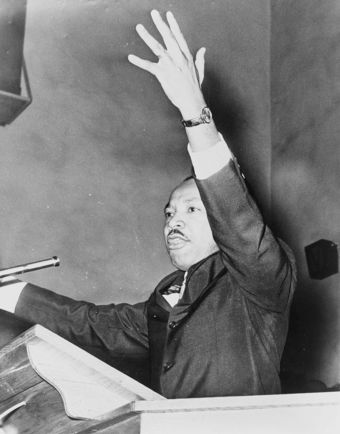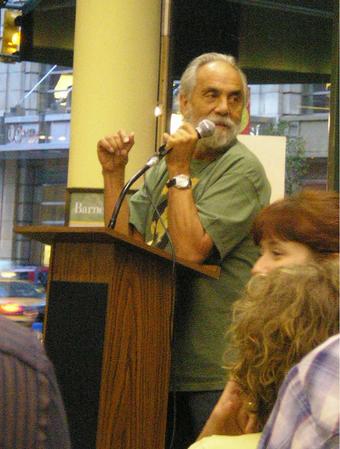12.1: Methods of Delivery
12.1.1: Defining a Successful Delivery
Delivery is “real” when the speaker is honest and talks with the audience without acting.
Learning Objective
List the four main qualities that make a speech “real” and describe their use
Key Points
- Ethical–Audiences expect a public speaker’s life to be a reflection of his or her message.
- Conversation–Audiences in North America seem to respond more favorably to public speaking that is a natural conversation.
- Interactivity–Audiences feel connected to speakers who talk with them, rather than at them.
- Eye contact–North American audiences expect the speaker to look them in the eye.
- Voice–Each audience member expects a conversational tone but also wants to hear and understand the speaker. Public speakers should always use a microphone to make sure everyone can hear.
- Gestures–Audiences expect to see gestures that feel natural, maintain interest, and help convey the message. Gestures may include movements of the hands, face, or other parts of the body.
Key Term
- ethics
-
The study of principles relating to right and wrong conduct.
Example
- Hamlet, Prince of Denmark, is airing his opinions about the proper manner of speaking upon the stage. HAMLET’S SPEECH Speak the speech, I pray you, as I pronounced it to you, trippingly on the tongue; but if you mouth it, as many of your players do, I had as lief the town-crier spoke my lines. Nor do not saw the air too much with your hand, thus, but use all gently; for in the very torrent, tempest, and, as I may say, whirlwind of your passion, you must acquire and beget a temperance that may give it smoothness. Oh, it offends me to the soul to hear a robustious periwig-pated fellow tear a passion to tatters, to very rags, to split the ears of the groundlings, who for the most part are capable of nothing but inexplicable dumb-shows and noise. I would have such a fellow whipped for o’erdoing Termagant. It out-herods Herod. Pray you, avoid it. Be not too tame neither, but let your own discretion be your tutor. Suit the action to the word, the word to the action; with this special observance, that you o’erstep not the modesty of nature. For anything so overdone is from the purpose of playing, whose end, both at the first and now, was and is, to hold, as ‘t were, the mirror up to nature; to show virtue her own feature, scorn her own image, and the very age and body of the time his form and pressure. Now this overdone, or come tardy off, though it make the unskilful laugh, cannot but make the judicious grieve; the censure of the which one must in your allowance o’erweigh a whole theater of others. Oh, there be players that I have seen play, and heard others praise, and that highly, not to speak it profanely, that, neither having the accent of Christians nor the gait of Christian, pagan, nor man, have so strutted and bellowed that I have thought some of nature’s journeymen had made men and not made them well, they imitated humanity so abominably. Oh, reform it altogether. And let those that play your clowns speak no more than is set down for them; for there be of them that will themselves laugh, to set on some quantity of barren spectators to laugh too, though in the meantime some necessary question of the play be then to be considered. That’s villainous, and shows a most pitiful ambition in the fool that uses it. Go make you ready.
Keeping it “real”
Successful delivery has two components according to Quintilian 9. A good man (or woman), speaking well has to be “real”, firstly you need to know and speak the truth; and secondly, you cannot be posing or acting when you speak.

Marcus Fabius Quintilianus
A statue of Quintilianus with his hand raised to speak to a crowd.
Ethics of the speaker
Being a real person is the ethical nature of public speaking. Quintilian considered the ethical nature of the speaker first. The speaker is obligated to be a person of good character and speak the truth.
Ethics, also known as moral philosophy, is a branch of philosophy that involves systematizing, defending, and recommending concepts of right and wrong behavior. It comes from the Greek word “ethos,” which means “character”. Not only must the speaker deliver the speech well but he/she must be a person of good character. From the very early days of studying rhetoric, ethics were important. The speaker could not just say one thing and then do something different; he/she was called upon to live by what the he/she was saying. Speaking well, also means speaking justly, where eloquence, wisdom and goodness combine. The Greek philosopher Socrates suggested that evil or bad actions are the result of ignorance and that any person who knows what is truly right will automatically do it. What do you think?

Socrates
Socrates using his “socratic” method as he teaches a student.
How does the speaker keep it real?
Let’s look at two important aspects of speaking well, which may serve as a guide.
Speaking as magnified conversation
In general, audiences in North America seem to respond more favorably to public speaking which is modeled as a natural, but magnified conversation. Public speaking is a conversation with the audience. Working with this model, you will find that certain behaviors will be more successful than others.
- Interactivity–Rather than talking “at” the audience, it’s better to be speaking directly “with” the audience. You should, at least mentally, conceive of the audience as responding, asking questions and approving or disapproving of what you are saying. In essence, you are not lost in your own train of thought while ignoring the thoughts of the audience. There is interactivity or a perception of give and take between the audience and yourself as the speaker.
- Eye contact–This is an important aspect of successful delivery for North American audiences. They expect you to look them in the eye. Here and in Western Europe, eye contact is interpreted the same way: conveying interest and honesty. People who avoid eye contact when speaking are viewed in a negative light, as withholding information and lacking in general confidence. However, in the Middle East, Africa, and especially Asia eye contact is seen as being disrespectful and even challenging of one’s authority. People who make eye contact, but only briefly, are seen as respectful and courteous.
- Voice–you want to speak naturally but loud enough to be heard by all the members of the audience. At a minimum, you need to be intelligible to the audience so that they can comprehend the message. If you are not able to be clearly heard by the audience, then you will want to get special help to improve pronunciation, stress and emphasis.
- Gestures–You are not an actor who takes on or plays a role, but rather, one who enlarges the gestures so that everyone can see. A gesture is a form of non-verbal communication in which visible bodily actions communicate particular messages, either in place of speech or together with and in parallel to words. Gestures include movement of the hands, face, or other parts of the body. Today, the conversational speaker, unlike the old school elocutionist who focused more on technique than substance, strives for natural gestures, which develop out of what is being said. As a conversational speaker you do not want to use planned or fixed gestures for dramatic effect. Additionally, you want to avoid any gestures that, out of nervousness or habit, might distract the audience from the message.
Requirements of the occasion
Conversational speaking or dialog with the audience does not mean that you are always informal or use casual speech. Different speaking occasions have different degrees of formality. The audience will judge, as so you need to adapt the appropriateness of dress, posture and word choice associated with how formal or informal the occasion may be. Ultimately, the successful speaker is really true to self and receives the desired response from the audience.
12.1.2: Choosing Your Method of Delivery
Speakers may or may not be able to choose a delivery method, but keeping best speech practices in mind leads to success in each situation.
Learning Objective
Develop your personal delivery style, considering the four methods of speech delivery
Key Points
- There are four common methods of delivery: impromptu (little or not preparation), memorization, reading from prepared manuscript, and extemporaneous (with outline or notes).
- Develop a speaking persona by manifesting your own honest and sincere personality without imitating the style of others when communicating with the audience.
- Have something to say. The first indicator that a person is speaking well is that the speaker will have something to say. Without ideas, opinions, or information, the speech wastes the speaker’s and the audience’s time.
- Speak honestly and with sincerity. Unless you thoroughly believe in the message you wish to convey to others, you are not likely to impress them favorably.
- Develop your own style; do not imitate. Speaking in a natural conversational style means that the speaker does not imitate the speaking style of other great speakers but may reflect their style or approach as it suits the speaker’s personality.
Key Terms
- persona
-
In the study of communication, persona is a term given to describe the versions of self that all individuals possess. The public persona will differ from the persona an individual will present when he/she happens to be alone.
- manuscript
-
A single, original copy of a book, article, or composition, written by hand or even printed.
- impromptu
-
Improvised; without prior preparation.
Implications for Selection of Method
Four Methods for Different Occasions
There are four common methods of delivery–impromptu with little or no preparation, memorization, reading from prepared manuscript, and extemporaneous with outline or notes. Often you will not have a choice in the method of the delivery; the demands of the situation or the occasion may dictate the method. For example, you may be called on to respond to what someone else has just said, or to add a few words with no time to prepare. Or, you could be called upon to read a proclamation or announcement.
Impromptu
On many different occasions you may be called upon to speak with little or no notice before hand. For an impromptu speech, you may have a minute or two to prepare in your mind before you speak. Additionally, you may be called on to read a letter, scripture, or article to a group without preparation.
Manuscript
You may need to use the manuscript that is provided without adding your own thoughts or comments. However, there are other situations where you will need to prepare your own manuscript— perhaps for publication in a newsletter or to make sure you include exact wording.
Memorized
You may need to memorize a brief speech, scripture, or perhaps a poem as your part in a presentation, rather than being given a manuscript to read .
Extemporaneous
In many situations you will have advanced notice, you can think about what you want to say to your audience and anticipate their responses as you develop an outline for your message. Extemporaneous is the most natural of all methods of prepared delivery where you can successfully achieve a more natural conversation with the audience.
Developing a Speaking Persona for Different Situations
You will want to develop your own persona for all methods of delivery. In the study of communication, persona is a term given to describe the versions of self that all individuals possess. You behave according to the desired impression you wish to create when speaking with others. A person may create or manifest different personas at different times, for different occasions. In particular, the persona you present before others when speaking will differ from the persona your present when you happen to be alone. Here are some important considerations for developing a natural, conversational persona for speech delivery.
Have Something to Say
The first indicator that a person is speaking well is that the speaker will have something to say. Without ideas, opinions, or information, talk becomes the most wasteful product in the world. It is not only a waste of time to the person who insists on delivering it, but a waste of time and patience to the people who are forced to listen. Shakespeare put a man who had nothing to say in to The Merchant of Venice and then had Bassanio describe him as follows:
“Gratiano speaks an infinite deal of nothing, more than any man in all Venice. His reasons are as two grains of wheat hid in two bushels of chaff: you shall seek all day ‘ere you find them, and when you have them, they are not worth the search.”
In essence, you need to think clearly and prepare the content of the message carefully before focusing on delivery.
Speak Sincerely
A second indicator of a good speaker is sincerity. Nothing can be substituted for personal sincerity. Unless you thoroughly believe in the message you wish to convey to others, you are not likely to impress them favorably.
Develop Your Own Style—Do Not Imitate
Speaking in a natural, conversational style means that the speaker does not imitate the speaking style of other great speakers but may reflect their style or approach as it suits the speaker’s personality. For example, shows British rapper Speech Debelle who has developed her own sincere, conversational delivery style in her 2012 album, Freedom of Speech. It is a fatal mistake to set out deliberately to imitate some favorite speaker, and to mold your style after that person. You may observe certain ways or methods in other speakers that will fit in naturally with your style and temperament, so you adopt them. Always be on your guard against anything that might impair your own individuality—even in the slightest degree.

British Rapper Speech Debelle
If you develop your own delivery style, you will always be prepared to give a good speech.
Remember that speaking is a perfectly normal act, which does not call for strange, artificial methods, but only for an extension and development of the familiar act of conversation. The objective is to develop and magnify your own honest and sincere persona as a speaker without imitation when communicating with the audience.
12.1.3: Speaking from a Manuscript
Your manuscript delivery method will vary depending on whether the manuscript is your own or someone else’s.
Learning Objective
Explain the advantages and disadvantages of delivering a speech directly from a manuscript
Key Points
- When provided with a manuscript, you need to deliver it exactly as written. It is the original author’s ideas and not your own that you are presenting to the audience.
- One important form of manuscript is a proclamation. When you read the proclamation, you create a distinct speech act that puts the statements into effect.
- After the speaker reads the manuscript and understands the meaning, he or she can practice creating a conversational delivery by emphasizing important words, creating vocal phrases with the right words together, and varying the pace and emphasis.
- If you are preparing your own manuscript for delivery, consider first the audience and write for them as if you were speaking directly to them.
- You can now use low cost personal teleprompters to help you deliver sermons, deliver speeches, and create quality audios.
Key Terms
- teleprompter
-
A teleprompter is a display device that prompts the person speaking with an electronic visual text of a speech.
- manuscript
-
A single, original copy of a book, article, or composition, written by hand or even printed.
- Proclamation
-
A statement which is proclaimed; a formal public announcement.
You may need to use the manuscript provided to you without adding your own thoughts or comments. However, there are other situations where you will need to prepare your own manuscript perhaps for publication in a newsletter or to make sure you include exact wording.
When Provided with a Manuscript
You need to delivery it exactly as written. You are delivering words which were prepared by someone else; they are the original author’s ideas and not your own that you are presenting to the audience. The manuscript could take many different forms. It could be a short story, a poem, or an article. You may also be provided with a special type of document, called a proclamation.

Manuscript
A medieval Latin manuscript by Aristotle with original Greek text added in the margins.
With a proclamation, the wording is exact and must be read exactly as written, as it is a distinct speech act that puts the statements into effect. If are reading a proclamation and say, “I now declare…” when you finish you have actually made it happen.
Advantages
You usually have time to prepare which will allow you to fully understand the meaning that needs to conveyed to the audience. Once you understand the meaning, then it is possible to practice reading to create a conversational delivery by emphasizing important words, create vocal phrases with the right words together, and vary the pace and emphasis to convey the meaning of the original. Since you will have the document with you, you can mark it to indicate where you want to add emphasis, pause, and change volume or pitch.
Disadvantages
Of course, the obvious disadvantge is that you are speaking for someone else; your are delivering his or her thoughts and ideas and not your own. You do not have ownership of the ideas but you may be judged since you are delivering the manuscript.
When preparing your own manuscript
If you are preparing your own manuscript for delivery, consider first the audience and write for them as if you were speaking directly to them. You are not writing a book but a speech to be delivered. When you deliver the speech from manuscript, you are challenged to make a connection with the audience rather than simply read words.
Advantages
Preparing your own manuscript prevents you from saying anything you would not say in careful consideration of your topic. It does assure that you say everything you want to say and gives the impression that you are a calm, collected thinker. You have the opportunity to work with a teleprompter to help you speak directly to the audience, but you will still need to practice with its speed and placement.
Disadvantages
There are disadvantages for the speaker preparing his or her own manuscript. It is a challenge, since the speaker will have difficulty maintaining eye contact with the audience to show warmth and sincerity. It may also be difficult for you to actually develop a conversation with the audience while reading. You want to sound natural and develop your own persona which is difficult if a person is just reading his or her words on a page. With the necessary practice, you can perfect and develop a speech and deliver it from a manuscript with careful rehearsal.
When Working with a Teleprompter
You may also work with a teleprompter to increase eye contact and presence with the audience.
Professional Teleprompters
A teleprompter (also called a telescript or an autocue) is a display device that prompts the person speaking with an electronic visual text of a speech or script. Using a teleprompter is similar to the practice of using cue cards. You can see the words on the screen in front of and usually below the camera lens of a professional video camera. The words on the screen are reflected to the eyes of the presenter using a sheet of clear glass or specially prepared beam splitter. Since you do not need to look down to consult written notes, you appear to be speaking spontaneously and can look directly into the camera lens or the audience.
Personal Teleprompters
Fortunately, there are inexpensive teleprompter software applications as well as free web-based teleprompter applications, which will allow you to use a teleprompter to help you deliver sermons, deliver speeches, and create quality audios. These entry-level products work on desktops, laptops, and even tablets.

Teleprompter in use
This teleprompter is in use for a broadcast.
12.1.4: Speaking from Memory
It to your advantage to memorize your speech in some situations, and a distracting disadvantage in others.
Learning Objective
Demonstrate how to deliver a speech from memory so that you appear natural and relatable to the audience
Key Points
- Memorized delivery takes two basic forms: the total speech or manuscript is committed to memory, or standard parts of the message are memorized and woven into each speech.
- Memorizing your speech allows you to stay in touch with your audience.
- One of the main problems of delivering a speech from memory is that it sounds like you are reading since you are focusing your attention on remembering the words.
- When writing your speech, write as if you were speaking naturally, directly to an audience.
Key Term
- extemporaneous
-
A type of speech delivery which involves preparation of speaker notes prior to delivery, associated with conversational style of delivery.
Uses of Memorized Delivery
Good orators of the past were expected to deliver their speeches from memory without notes or other aids. Today, you may find it to your advantage to memorize your speech or presentation.
Today, memorization takes two basic forms:
- The total speech or manuscript is committed to memory.
- Standard parts of a message are memorized and woven into each speech.
Advantages
If you memorize your speech you are more likely to perform better than the speaker reading from a manuscript, since you can stay in touch with your audience. When speaking from memory, you do not need to think about what is coming next or how to express an idea as you would in extemporaneous speaking; therefore, you can give more attention to the audience. Today, we generally admire and stress extemporaneous speaking in our society, but many of the great speeches in history were delivered all or partially from memory.
Disadvantages
One of the main problems of delivering a speech from memory is sounding rehearsed, or like you are reading. It is possible to memorize and deliver a speech with variety and emphasis.
Tips for the Speaker
You may use various approaches to memorize and rehearse your speech. Below are some guidelines to follow when delivering a memorized speech:
- When writing the speech, write as if you were speaking naturally, directly to an audience.
- Develop an outline of the main points and then memorize the outline.
- If delivering the same speech to different audiences over time, memorize the individual sections and then weave them together for each occasion.
- If you forget a word or two or a small section, just continue speaking.

Engage the Audience
To be successful, a speaker should connect with the audience, not just recite words.
Overall, if you have the attitude that you are communicating with an audience rather than reciting words, you are likely to succeed.
12.1.5: Impromptu Speeches
An impromptu speech is given with little or no preparation, usually about a topic that the speaker knows well.
Learning Objective
List ways to quickly prepare when called upon to give an impromptu speech
Key Points
- Remember that you are generally in control of the content, so you can decide what you are going to talk about and include topics you want to talk about.
- Your delivery will naturally be more conversational and spontaneous.
- Since you are not well-prepared, you may overlook some significant information, but audience questions can often help fill in the gaps.
- Become familiar with common organizational patterns so you can apply them in any situation using the three part speech outline of an Introduction, Body, and Conclusion.
Key Term
- impromptu
-
Improvised; without prior preparation.
Impromptu Speech
An impromptu speech is given with little or no preparation, yet almost always with some advance knowledge on the topic. When called to speak “off the cuff” on the “spur of the moment,” is is usually because the speaker is quite knowledgeable about the subject. For example, if called on to speak in class, a student might give a short impromptu speech about a topic that was in the assigned readings. Business meetings also use a “check in” to tell everyone else about a current project. In small informal meetings, the audience will interrupt an impromptu speech and ask questions, which helps guide the speech and the information that is presented. When campaigning, politicians sometimes respond to reporters or voters almost anywhere and at any time.

Impromptu Speech
Mohamed el-Beltagy, running for the lower house of Parliament, stops to give an impromptu speech.
Advantages
Remember that you are generally in control of the content you are presenting, so you can include topics that you want to talk about. Additionally, you can use personal examples from experience to support what you are saying. Since you are an authority on the topic, you want to speak with conviction like you really mean it. Your delivery will naturally be more conversational and spontaneous. Since you are not prepared with pages of notes, you are more likely to speak directly to the audience just like if you were speaking to another person in a conversation.
Disadvantages
Since you are not well-prepared, you may have difficulty thinking of what to say or formulating the ideas once you get up to speak. Although you are familiar with the topic, your speech may lack details and supporting information. If the audience is passive and does not ask questions to guide you, you may overlook some significant content. Hopefully, someone in the audience will ask questions so you can fill in gaps. Additionally, impromptu speaking is rarely appropriate for occasions which require more reasoned discourse with supporting ideas or more formal events.
Tips for the Speaker (Impromptu Preparation)
What do you do if you are asked to speak at the last minute? It is best to become familiar with common organization patterns so you can apply them in any situation and then also consider what you have been asked to speak about. Are you presenting your opinion? State your opinion, the reasons why you support that opinion, and conclude. Is it something that happened? Retell the event from beginning to end (first, next, then, etc.). Is it a demonstration? Explain each step in the process from first to last.
- Make sure to plan an introduction and a conclusion. If possible, take a few moments to think about what you want to say to introduce the topic and have some way of concluding.
- Make a few notes for yourself on a card, phone, or iPad. Or, text yourself a few single words to remind yourself of the important ideas.
- Consider the simple three part outline of an Introduction, Body, and Conclusion, and fit your ideas into that pattern.
- Do not try to remember a detailed outline for your entire speech; just remember the order of important points.
- Be sure to stop when you have made your points.
- If you do not know what to say next, you can summarize and paraphrase what you have just said, and then will probably be ready to move on to the next topic.
- Remember that, in most situations, you will know more about the subject than the audience. Usually you will not be called up to speak impromptu about something you know nothing about, so you have probably spoken about the general topic before or you probably have knowledge to share with others.
- Talk like you mean it. In other words speak with conviction. You are explaining your ideas or knowledge and you are an authority.
- Relax!
12.1.6: Extemporaneous Speeches
Extemporaneous, the most natural method of delivery, involves glancing at notes while maintaining crucial eye contact with the audience.
Learning Objective
Give examples of note-taking strategies for extemporaneous speeches
Key Points
- There are two popular methods for organizing ideas to create a graphical representation for speaker notes–outlining and mind or concept mapping.
- An outline is a list of items with each item divided into additional sub-items. Each level in an outline has at least two subcategories. There are three basic types of hierarchical outlines–sentence, topic and phrase.
- Topic and phrase are the most useful for speaker notes since they allow the speaker to quickly glance at the notes while maintaining eye contact with the audience.
- Mind mapping and concept mapping are visual representation of ideas and concepts. Both mind maps and concept maps can be used to graphically show the relationship between ideas for a speech and as speaker notes for delivery.
- A mind map diagram starts with a single word as a central branch node and lesser categories as sub-branches going off from the central node. A concept maps can have multiple hubs or nodes with clusters of concepts labeled to show the kind of relationship.
- While extemporaneous speaking may be free of the constraints of memorization and manuscript speaking, it is not careless talk; the speaker prepares notes in advance in order to deliver an organized speech.
Key Terms
- mind map
-
A diagram used to represent words, ideas, tasks or other items linked to and arranged radially around a central key word or idea.
- concept map
-
A diagram showing the relationships among concepts, with the concepts drawn in rectangular boxes, which are connected with labelled arrows that denote the relationships between concepts, such as “is a,” “gives rise to,” “results in,” “is required by,” or “contributes to.”
- extemporaneous
-
A type of speech delivery which involves preparation of speaker notes prior to delivery, associated with conversational style of delivery.
Extemporaneous Speech
Extemporaneous speaking is one of the most natural methods for delivering a prepared speech. You can use an extemporaneous speech to achieve a more natural tone, flow and style with the audience.
First, think about your topics and anticipate the audience’s reception to your speech. You can develop speech notes based on this preparation and use them to aid you during the presentation.
Preparing Speech Notes
There are two popular methods for creating a graphical representation for notes: outlining, and mind or concept mapping.
An outline is a list of items with each item divided into additional sub-items. Each level in an outline has at least two subcategories. There are three basic types of outlines:
- Sentence outline – Each complete sentence includes a heading or single sentence about the subject of the outline.
- Topic outline – Each topic is listed and functions as a subtopic of the outline’s subject.
- Phrase outline – Each short phrase entry is a subtopic of the aforementioned main entry.
Speaking notes, topic outlines, and phrase outlines have an advantage over sentence outlines. For example, you can easily look at your notes for reference and as a personal reminder of which topics to discuss as you’re speaking.
Outlines commonly take two forms: alphanumeric and decimal.
An alphanumeric outline includes a capitalized number or letter at the beginning of each topic. Look at the sample:
Thesis statement: E-mail and internet monitoring is an invasion of employees’ rights
I. The situation: Over 80% of today’s companies monitor their employees.
….A. To prevent fraudulent activities, theft, and other workplace related violations.
….B. To more efficiently monitor employee productivity.
II. What are employees’ privacy rights when it comes to electronic monitoring and surveillance?
….A. American employees have basically no legal protection from mean and snooping bosses.
……..1. There are no federal or State laws protecting employees.
……..2. Employees may assert privacy protection for their own personal effects.
….B. Most managers believe that there is no right to privacy in the workplace.
……..1. Workplace communications should be about work; anything else is a misuse of company equipment and company time.
……..2. Employers have a right to prevent misuse by monitoring employee communication.
Decimal outline
The decimal outline shows how each item at every level relates to the whole sample.
Thesis statement:
1.0 Introduction
….1.1 Brief history of Liz Claiborne
….1.2 Corporate environment
2.0 Career opportunities
….2.1 Operations management
……..2.1.1 Traffic
……..2.1.2 International trade and corporate customs
……..2.1.3 Distribution
….2.2 Product development
The outline could be printed or handwritten as in this expert from Richard Nixon’s Checkers speech.

Speech Notes
Notes from Richard Nixon’s Checkers speech.
Mind Mapping and Concept Mapping
Mind mapping and concept mapping are visual representations of ideas and concepts. A mind map is a diagram which starts with a single word and then branches out from the central node, with lesser categories as sub-branches of the larger branches. Concept maps are more free-form, since multiple hubs and clusters can be created. Unlike mind maps, concept maps do not fix on a single conceptual center.
For example, in the mind map for student learning , you can view the main component idea and related ideas which connect to its branch nodes. You can also use a mind map as speaking notes.

Mind Map
A mind map is a diagram that starts with one word and expands into additional categories.
Practice and Rehearsal Guidelines
The following guidelines are best practices on how to practice and rehearse an extemporaneous speech:
- Speak in a conversational style by pretending you are with your audience.
- Rehearse with your graphics and coordinate them with your talk.
- Display your graphics only when you are talking about them.
- Rehearse in front of others and solicit feedback.
- Record and listen to your timed practice speech.
- Prepare for interruptions and questions at the end.
Although extemporaneous speaking may not require memorization and manuscript speaking, organize and prepare your content and notes ahead of time to deliver a speech that will be well received by your audience .

Free Speech
“Free speech doesn’t mean careless talk!” produced by the Office for Emergency Management.
12.1.7: Key Differences Between Prepared and Impromptu Speeches
The key difference between a prepared and impromptu speech is the amount of time given to the speaker to rehearse and prepare.
Learning Objective
Differentiate between prepared and impromptu speeches
Key Points
- An impromptu speech is one where the speaker is given no preparation time at all.
- A prepared speech is one where the speaker is given the topic well in advance and the speaker is given time to research it and rehearse the speech.
- The different type of prepared speeches include extemporaneous, memorized, and manuscript.
Key Term
- impromptu
-
Improvised; without prior preparation.
Differences Between Prepared and Impromptu Speeches
There are several different types of speeches that one can deliver. They range from perfectly memorized, to completely off the cuff with no preparation at all.
Prepared Speech
The most common type of speech is a prepared speech. For a prepared speech, the speaker was been given the topic in advance, had time to do background research on it, and has practiced delivering the speech.
This type of speech may be used when giving a presentation or speaking in a business meeting.

Using PowerPoint Slides
PowerPoint slides can be used in a prepared speech.
However, preparation does not necessarily mean memorizing every word. A prepared speech can be an extemporaneous, manuscript, or memorized speech, or a combination of these techniques. An extemporaneous speech is often delivered with the aid of note cards to help the speaker remember key points and content order. A memorized speech is one that is recited from memory without the aid of scripts or cue cards. A manuscript speech is one that has the entire speech written out for reference.
When preparing for a speech one should:
- Rehearse the speech as it will be presented (that is, with visual aids, standing or sitting as will be appropriate for the real speech, etc.)
- Time the rehearsal
- Rehearse in front of others
- If possible, rehearse in the location where the speech will be delivered to become more comfortable in the space, see how the audience will view the speech, and see how much space is available for movement
- Create a visual and audio recording of the speech, and look for areas where body language or vocal performance should be improved
Impromptu Speech
Another type of speech that is less commonly seen in society (but nonetheless very useful to understand) is the impromptu speech. Impromptu speaking occurs when the speaker is given no time to prepare for the speech; he or she is given a topic and must immediately begin speaking on it. This speaking style involves thinking on one’s feet and being able to plan the flow of the speech as the speaker is giving it.
While this seems like a difficult style in which to give a speech, most speech in a person’s daily life is impromptu. People do not background research on every conversation or prepare for hours before speaking to friends. However, having to give this kind of a speech to an audience or on a topic one is not so familiar with can definitely be a challenge.
The most common example of a real world impromptu speech is the elevator pitch. When in an unanticipated situation where one is speaking to someone who has the ability to advance one’s career or provide an opportunity in a new field, it is crucial to be able to deliver an excellent impromptu speech.
12.1.8: Additional Notes on Preparing and Delivering Impromptu Speeches
An impromptu speech is given with little or no preparation, but the presenter is usually very knowledgeable about the subject matter.
Learning Objective
Describe methods to successfully deliver an impromptu speech
Key Points
- Anticipate common questions; if you are asked about your line of work at a social event, you can have a response prepared. Having an elevator pitch ready is one way to prepare.
- If you think you will be called on to speak, it is a good idea to take a few minutes and make notes on important points.Select a familiar organizational pattern and then add an introduction and summary conclusion statement to the main ideas.
- You want to maintain eye contact, speak directly to the other person(s,) and minimize noise which will interfere with your delivery at an informal event.
- In a formal, stand-up event you want to put comments in context of the occasion, maintain eye contact while glancing at notes, and use internal summaries and transitions to show progress as you move to the conclusion.
- In a Q&A session, you want to listen attentively and repeat the question that you are answering. If you do not know the answer, say so and make arrangement for a follow-up electronic response.
Key Term
- impromptu
-
Improvised; without prior preparation.
Additional Notes on Preparing and Delivering Impromptu Speeches
An impromptu speech is given with little or no preparation. However, you will generally be called up to speak about a topic in which you are familiar or considered an expert. Impromptu speeches can take many different forms and occur in different situations. There are ways to prepare and deliver impromptu speeches by anticipating the more common impromptu contexts.
Preparation—Think before you Speak!
Anticipate Common Questions
In certain situations you can anticipate the types of questions or requests which will require a seemingly impromptu response. For example, you might be asked about your line of work at a social event. Since you know your occupation, you can have a response prepared. You might have a special project or interest that you want to pitch to others.
Elevator pitch
An elevator pitch is a short summary used to quickly identify what you do or what project is important to you in about 30 seconds, or the length of an elevator ride. So, when someone asks you what you do for a living, you can quickly and seemingly without preparation give an impromptu pitch or description.
Stand-up Speaking Event
If you think you will be called on to speak, it is a good idea to take a few minutes and make notes on the important points before you speak:
- Apply a three part plan for speech. You have learned about the three part speech structure, which are Introduction, Body and Conclusion. Apply the structure and think about your main points and thesis. List two or three main ideas for the body, develop the introduction by creating an opener, and present your conclusion with a summary and a reference to the opening statement from the introduction.
- Use a common organizational pattern. Think about the common patterns of organization with which you are already familiar: topical, spatial, chronological, and problem/solution—choose the one that fits the ideas you have just jotted down.
- Use phrases and single line notes. Make sure to make your notes as one line phrases in outline form. You can put your notes on paper or any device that allows you to quickly glance at a line and back up at the audience (like your smartphone).
Often, you will be presenting content that you have already covered with other audiences. On those occasions, you can use the same content but you will need to modify the introduction to reference the current occasion or audience.
Delivery
Informal Context
Many situations can be informal social occasions, meetings, or one-on-one talks where you could be standing or sitting.
- Maintain eye contact—it is important in Western cultural settings to look directly at the person you are speaking to so that you have each other’s attention.
- Eliminate noise—you want to make sure that you can actually hear each other easily in a noisy room. If you are experiencing noise, you might suggest stepping aside to a less noisy corner to delivery your short message.
Informal Meetings and Q&A
Impromptu speeches are usually used in short informal meetings where the audience can interrupt and ask questions to help guide the speech and retrieve the information they need from the speaker. It is important in this situation to stay focused by repeating the question and answering it without going off on a tangent.
Stand-up Speaking Context
There are situations where you will be asked to share a few words with a large audience.You will want to apply your knowledge of public speaking to deliver a short, organized speech.
- Put comments in context—you may want to start by putting your comments in context as a way of introducing your message. For example, you may refer to the occasion or the previous speaker.
- Maintain eye contact—hopefully, you had a few minutes to prepare so that you can glance at your one line notes and then back up to the audience.
- Use summaries and transitions—make sure to summarize and show connections between ideas; at the end, bring the message to closure with a summary statement.
Formal Speech with Q&A Session
Following a speech you will often participate in a Q & A session. Members of the audience will ask questions and you will respond without time to prepare:
- Listen attentively to the question, repeat it, and provide a short focused answer .
- If you do not know the answer, say so and make arrangements to respond later electronically.
You are the expert; you will know more about the topic than your listeners. Remember that the listeners want to hear what you have to say, even if it is slightly disorganized.

Q&A Sessions
Tommy Chong listens attentively during a Q&A session.
12.2: Speaking in the Real World
12.2.1: Practical Tips for Speaking in Non-Academic Settings
Non-academic speeches still require understanding your audience, adequate preparation, structure and a mindfulness of the occasion.
Learning Objective
Give examples of non-academic speeches and how to prepare them
Key Points
- Two types of speeches given in non-academic settings are entertainment speeches and persuasive speeches.
- To be successful in an entertainment speech, you must adapt to your audience and be mindful of the time.
- Essential tips for persuasive speaking include understanding your audience, focusing on the speech’s end result, using words with heavy emotional appeal, and identifying why your topic is important.
Key Term
- persuasion
-
is the influence of beliefs, attitudes, intentions, motivations, or behaviors.
Two types of speeches given in non-academic settings are entertainment speeches and persuasive speeches. Entertainment speeches may be given at a wedding or other social event. Persuasive speeches may be given as part of a political campaign or at a charity event.
Some examples of places where someone might be invited to give a non-academic speech:
- Rotary club
- Wedding
- Political campaign or event
- Charity event or benefit
- Acceptance speech of an award
- Reception or banquet
- Conference dinners or lunches
- Grievance Speech at a funeral
- Informative speech (keynote speaker)
- Interviews

Wedding Toast
A wedding toast is an example of an entertainment speech.
Practical Tips for Entertainment Speeches
People often make the mistake of thinking they can improvise, or “wing,” an entertainment speech by telling a few jokes or funny stories. In many cases, instead of being entertaining, the speech falls flat. Therefore, it is very important to prepare your entertainment speech. Some questions you should consider before giving an entertainment speech include:
- Is the content appropriate for the occasion?
- What do you know about your audience? Will they respond well to the content of your speech?
- Is the speech too short or too long? (Toasts, for example, are typically no longer than a few minutes.)
Practical Tips for Persuasive Speeches
In a political setting or money-raising campaign, a persuasive speech may be used to get audience members to change their attitudes or beliefs about a certain topic. In the case of fundraising, the speech is meant to convince people that the cause is worthy of a donation. To be as persuasive as possible, a speaker needs to understand some basic information about persuasion:
- Focus on the end result of your speech when preparing – all parts of your speech should focus on the end goal of your persuasive topic.
- Relate to and understand your audience – Start your speech by finding common ground with your audience, using humor or other similarities you might have. People tend to like people who are similar to them in some way.
- Chose your words wisely – focus on terms that have heavy emotional appeal like “freedom,” “right,” “wrong” and “liberty. “
- Identify why your persuasive topic is relevant to your audience- this will heighten interest and make your speech more immediately important. This is particularly important for persuasive speeches requiring a quick action by the audience.
Some additional resources on practical public speaking tips:
These additional resources provide tips on public speaking and include both videos and lists of tips to make your non-academic speech as engaging as possible.
- http://www.toastmasters.org/tips.asp – A public speaking society with tips on giving speeches.
- http://www.presentationskills.ca/Practical-Speaking-Tips.html – Speaking tips for professionals
- http://www.mindtools.com/CommSkll/PublicSpeaking.htm – Article on public speaking tips and improving confidence.
- http://www.youtube.com/watch?v=AykYRO5d_lI – Public speaking tips from Toastmasters (a public speaking society).
12.3: Effective Vocal Delivery
12.3.1: Volume
Speakers control the production of sound either using their own voice or a microphone so that amplified sound is loud enough to be heard.
Learning Objective
List methods of using volume to effectively deliver your speech
Key Points
- Volume is the perceived loudness of the speaker. Loudness is what the audience actually perceives and it correlates with the physical strength (amplitude).
- When speaking naturally without any amplification, you need to keep in mind the distance to be covered by your voice and adjust sound production accordingly.
- In large rooms or when using videoconferencing equipment, you use a microphone to convert sound into electrical signals for amplification.
- Lavalier mics, commonly used by speakers, are usually attached to collars or ties with small clips. The cord may be hidden by clothes and either run to a radio frequency transmitter or into a mixer.
Key Terms
- loudness
-
The characteristic of a sound that is primarily a psychological correlate of physical strength (amplitude). More formally, it is defined as “that attribute of auditory sensation in terms of which sounds can be ordered on a scale extending from quiet to loud. “
- amplifier
-
This is a particular type of speaker used to amplify voices and musical instruments at live performances.
- Lavalier Mic
-
A lavalier microphone or lavalier (or lav or lapel mic) is a small electret (electric, magnet) or dynamic microphone used for television, theater, and public speaking applications, in order to allow hands-free operation.
Volume
Volume is the loudness of the speaker. It is the psychological characteristic of physical strength (amplitude). It is perceived as auditory sensation by the listener which can be ordered on a scale from quiet to loud. Loudness is then a subjective measure of the listener, which is often confused with objective measures of sound strength such as sound pressure level (in decibels), sound intensity, or sound power. Amplitude is the strength or power of the wave signal. Higher amplitudes on the wave graph are interpreted as a higher volume, hence the name “amplifier” for a device that increases amplitude.

Determining the Volume
Higher amplitude will be perceived as louder sound.
Using the “Naked” Speaking Voice
When speaking naturally without any amplification you need to keep in mind the distance to be covered by your voice. You might compare speaking with the act of throwing a ball. Consider how much more muscular effort is needed to throw the ball a long distance than is required to throw it a short one. As you speak, think of your words as balls and mentally watch them covering the space between you and your audience. Notice how you unconsciously lengthen the voice. If speaking in a face-to-face group without a microphone ask yourself if you are loud enough to be heard by audience members in the last row. Speaking to a large group will require more energy to breathe and control your sound production.
To become a better speaker with your “naked” speaking voice, try the following techniques:
- Practice speaking in a large room with a friend who moves farther and farther away from you until the friend reaches the rear of the room and can still hear you.
- Make sure that you are standing straight and not cramped so you have the maximum capacity for breathing and forcing air out of the lungs for sound production.
- Practice speaking by thinking of people at different distances to you such as at your elbow, across the room, or in the back of a large hall.
Using a microphone
In large rooms or when using videoconferencing equipment, you will use a microphone to convert sound into electrical signals for amplification. The signal may then be sent to an amplifier. The electronic amplifier increases the power of a signal. It does this by taking energy from a power supply and controlling the output to match the input signal shape but with a larger amplitude. A loudspeaker or headset receives the input to produce the amplified sound.

Microphone
Microphones are used by a speaker for large audiences, during recording, or when videoconferencing.
There are several different types of microphones that the speaker might commonly use in different situations, such as:
- Hand-held mics – High quality mics usually attempt to isolate the diaphragm from vibrations using foam padding, suspension, or some other method. Low quality mics tend to transfer vibrations from the casing right into the diaphragm, resulting in a terrible noise.
- Lavalier mics – These are attached by a small clip to the clothing of the speaker, usually to collars or ties. The cord may be hidden by clothes and either run to a radio frequency transmitter or a digital audio recorder kept in a pocket or clipped to a belt (for mobile work), or directly to the mixer. These usually do not have protection from handling noise.
- Stationary mics – These are permanently attached to a podium. With an attached microphone, you are limited to the space immediately in front of the podium. Some stationary mics are in a holder on the podium, which can be removed to allow you to move around at least the length of the connecting cable.
Microphones can be placed in several different arrangements in the room for recording or videoconferencing, such as:
- In close – The microphone is placed relatively close, within three to twelve inches, which reduces extraneous noise.
- In distant or ambient miking – The microphone is placed at some distance from the speaker. The goal is to get a broader, natural mix of the sound source, along with ambient sound, including reverberation from the room or hall.
- In room miking – This is used together with a close microphone, sometimes during the speaker Q&A.
To make the most out of a microphone, a speaker should consider these techniques:
- Hold the microphone about six to eight inches from your mouth and speak over the microphone.
- Make sure you have the right microphone for speaking. Don’t just use whatever mic is at hand.
- Note that lavalier mics do not usually have protection from handling noise. It is therefore important to make sure they will not be moved or bumped.
- Conduct a sound check with any microphone. Make sure to test with the speakers in the actual room.
12.3.2: Rate
Rate is the speed of speaking in words per minute from slow to fast, with normal rate averaging about 125 words per minute.
Learning Objective
Use variance in the rate at which you speak to convey different emotions or emphasize important parts of your message
Key Points
- You can vary the rate depending of the emotions you are feeling or the type of message you are communicating. If you are experiencing joy, you will speak at a fast rate compared to a speaker who is expressing surprise who will speak at a much faster rate.
- When speaking you want to speak at a varied rate so that you can emphasize important parts of your message.
- Do you speak fast because you are in a hurry to finish or are nervous? Caution, slow down!
Key Terms
- rate
-
speed of speaking, measured in words per minute
- paralanguage
-
The non-verbal elements of speech used to modify meaning and convey emotion, such as pitch, volume, and intonation.
Rate is Speed of Speaking Measured in Words Per Minute
Rate is how fast or slow a person speaks. Rate is part of the paralanguage of speech along with loudness and pitch. It is not language but it accompanies all of your spoken use of language and can convey attitude and emotion. You can vary the rate depending on the emotions you are feeling or the type of message you are communicating. For example, if you are experiencing joy, you will speak at a fast rate compared to a speaker who is expressing surprise who will speak at a much faster rate. Normally, you speak about 125 words per minute. But you may speak much slower at about 100 wpm if you are giving a slide presentation.
You will find that the rate of speaking in audiobooks is about 150-160 words per minute whereas auctioneers can speak at about 250 wpm. According to the Guinness World Record, the current fastest speaker is Steve Woodmore, who was clocked at a rate of 637 wpm. Caution–slow down a minute to consider what you might do with your speech rate to be more effective.

Warning Sign
Just like a traffic sign warns about certain upcoming speed limits, a speaker needs to monitor their rate during a speech.
Tips for Speakers
- When speaking you want to speak at a varied rate so that you can emphasize important parts of your message.
- You also want to change the rate for the mood or emotion of the message and the occasion. If you want to show excitement at a pep rally you will naturally speak at a faster rate than if you were speaking at a funeral where you would speak slower because you are sad or contemplative.
- You might also speak slower if you are making choices and thinking carefully about what you are saying; a slower pace may conveys your thoughtfulness to the audience.
- Use a recorder to record your speech so you can clock your actual speaking rate.
Finally, ask yourself if you are speaking too fast because you are nervous!
12.3.3: Pitch
Changing the pitch while speaking can convey shades of meaning such as emphasis or surprise, or distinguish a statement from a question.
Learning Objective
Define pitch and describe how pitch changes can change the meaning of sentences
Key Points
- Pitch is the auditory attribute of sound ordered on a scale from low to high. You can think about the notes on a musical score with pitch getting higher as you move up the scale.
- For men and women the size difference of the vocal folds, reflecting male-female differences in larynx size, will influence pitch range so that adult male voices are usually lower-pitched with larger folds than female voices.
- Consciously or unconsciously the speaker will use different patterns of pitch to convey different meanings to the listener.
- In public speaking you can apply changes in pitch not only to a single word such as an exclamation, “Oh! ” but to any group of syllables, words, and even sentences to convey different meanings.
- Avoid monotony, speaking with one pitch tone or little variety in pitch. Make sure to vary the speech as you speak to show emphasis and change in meaning.
Key Terms
- intonation
-
The rise and fall of the voice in speaking. Some texts use “inflection” instead of intonation to indicate change in pitch.
- pitch
-
The perceived frequency of a sound or note. Higher frequency notes are higher pitch and lower frequency notes are lower pitch.
Pitch Is Ordered on a Scale from Low to High
Pitch is the auditory attribute of sound ordered on a scale from low to high. You can think about the notes on a musical score with pitch getting higher as you move up the scale. Pitch is closely related to frequency of sound waves; it is almost entirely determined by how quickly the sound wave is making the air vibrate and has almost nothing to do with the intensity, or amplitude, of the wave, which relates to loudness. That is, “high” pitch means very rapid oscillation, and “low” pitch corresponds to slower oscillation.

Measuring the Pitch
The higher pitch sounds move up the treble clef and the lower pitch sounds move down the bass clef.
Pitch for Male and Female Speakers
As a speaker you want to find a pitch that is suitable for speaking. Generally, you want to use a pitch range that would normally be comfortable for your natural conversation. For men and women the size difference of the vocal folds, reflecting male-female differences in larynx size, will influence available pitch range. Adult male voices are usually lower-pitched and have larger folds. The male vocal folds are between 17mm and 25mm in length. The female vocal folds are between 12.5mm and 17.5mm in length.
Uses of Pitch for Communicating Different Meanings
The pitch or pitch contour in which a syllable is pronounced conveys shades of meaning such as emphasis or surprise, or distinguishes a statement from a question. All languages use pitch pragmatically as intonation (or inflection as is used in some texts) to communicate different meanings—for emphasis, to convey surprise or irony, or to pose a question. Generally speaking, there are four types of pitch changes you can make, as follows:
- Rising intonation means the pitch of the voice rises over time [↗];
- Falling intonation means that the pitch falls with time [↘];
- Dipping intonation falls and then rises [↘];
- Peaking intonation rises and then falls [↗].
Consciously or unconsciously the speaker will use the different patterns of pitch to convey different meanings to the listener. Consider the uses of pitch change and the associated meanings in the different categories as follows:
- Informational: for example, “I saw a ↘man in the garden” answers “Whom did you see? ” or “What happened? “, while “I ↘saw a man in the garden” answers “Did you hear a man in the garden? “
- Grammatical: for example, a rising pitch turns a statement into a yes-no question, as in “He’s going ↗home? “
- Illocution: the intentional meaning is signaled by the pitch pattern, for example, “Why ↘don’t you move to California? ” (a question) versus “Why don’t you ↗move to California? ” (a suggestion).
- Attitudinal: high declining pitch signals more excitement than does low declining pitch, as in “Good ↗morn↘ing” versus “Good morn↘ing. “
- Textual: information not in the sentence is signaled by the absence of a statement-ending decline in pitch, as in “The lecture was canceled” (high pitch on both syllables of “cancelled”, indicating continuation); versus “The lecture was can↘celed. ” (high pitch on first syllable of “canceled”, but declining pitch on the second syllable, indicating the end of the first thought).
In public speaking you can apply changes in pitch not only to a single word such as an exclamation, “Oh! ” but to any group of syllables, words, and even sentences to convey different meanings. You can change pitch of successive syllables in a word, word groups, or successive sentences. You want to make sure that you use pitch to convey the intended meaning so that you do not drop the pitch, for example, until you have completed an idea.
Additionally, in natural conversation pitch changes make some words stand out more than others, you can do the same in your public speaking for emphasis. You can use pitch to draw the listeners’ attention to words or phrases that are more important than others. When speaking you will naturally use a range of pitches to convey different meanings.
Speaker Tips
- Avoid monotony, speaking with one pitch tone or little variety in pitch. Make sure to vary the speech as you speak to show emphasis and change in meaning.
- Practice saying sentences with different intonation patterns to change the meaning. For example, if you make a statement with falling intonation at the end, you can turn it into a question by raising the intonation at the end. Try for example, “See what I mean,” and “See what I mean? “
12.3.4: Pauses
A speaker may use pauses to enhance the message delivery; a speaker may also user filler words and pauses that distract from the message.
Learning Objective
Classify pauses as effective or ineffective
Key Points
- You may use a pause to emphasize that the information coming next is important, or to give the audience time to process what you have just said.
- Repetitive, unnecessary pauses like speech disfluencies, filler pauses, false starts—particularly filler words such as like, you know, and so—can distract from the message.
- Record a conversation and count the use of unnecessary pauses and filler words in relation to the other words in the speech. See if you can reduce the ratio over time.
Key Terms
- filler
-
A sound or word that is spoken in conversation by one participant to signal to others that he/she has paused to think but is not yet finished speaking.
- Pause
-
Pause may refer to a rest, hesitation, or temporary stop.
- disfluencies
-
Speech disfluencies are breaks, irregularities, or non-lexical vocables that occur within the flow of otherwise fluent speech. These include false starts, fillers, and repaired utterances (correcting slips of the tongue or mispronunciations).
Pauses
Pauses can enhance delivery or be filled needlessly and distract the audience.
A pause may refer to a rest, hesitation, or temporary stop. It is an interval of silence and may vary in length. The speaker may use pauses to enhance the message delivery or fill the pauses needlessly and distract the audience from the message.
Efficient and Effective Pauses
You may use a pause to emphasize that the information coming next is important, or to give the audience time to process what you have just said . Consider some of the ways that you might use pauses effectively in your delivery.

Using Pauses
Jimmy Wales pauses for dramatic effect in response to Amanda Cogdon at the 2006 Time 100 gala.
- Pause enables the speaker to gather thoughts before delivering the final appeal: pause just before the utterance, think about what you want to say, and then deliver your final appeal with renewed strength.
- Pause prepares the listener to receive your message: pause and give the attention powers of your audience a rest. The thought that follows a pause is much more dynamic than if no pause had occurred.
- Pause creates effective suspense: suspense can create interest. The audience will want to find out the conclusion or what happened if you pause before the punch line or conclusion.
- Pause after an important idea: pausing gives the audience time to process what you have just said before you continue with your delivery.
- Pause at the end of a unit: you may pause to signal the close of a unit of thought, such as a sentence or main point.
Ineffective Pauses
Different types of pauses that could present problems for the speaker:
Speech Disfluencies
Speech disfluencies are breaks, irregularities, or non-lexical vocables that occur within the flow of otherwise fluent speech, including false starts (words and sentences that are cut off in the middle), phrases that are restarted and repeated, grunts, or fillers like uh, erm, and well.
Filled Pauses
Filled pauses are repetitions of syllables and words; reformulations; or false starts, where the speaker rephrases to fit the representation of grammatical repairs, partial repeats, or searching for words to carry the meaning.
Filler Words
Filler words are spoken in conversation by one participant to signal to others that he or she has paused to think, but is not yet finished speaking. Different languages have different characteristic filler sounds. The most common filler sounds in English are: uh /ə/, er /ɚ/, and um /əm/.
Today’s youth uses other fillers. The following are among the more prevalent:
- y’know,
- so,
- actually,
- literally,
- basically,
- right,
- I’m tellin’ ya,
- you know what I mean.
Placeholder
Names
Placeholder names are filler words like thingamajig, which refer to objects or people whose names are temporarily forgotten, irrelevant, or unknown.
Tips for speaker
Record a conversation and count the use of unnecessary pauses and filler words in relation to the other words in the speech. See if you can reduce the ratio over time.
Remember that as you become more confident and familiar with speaking it will be easier to reduce the frequency of many of the unnecessary filler words and pauses.
12.3.5: Articulation and Pronunciation
Articulation focuses on making individual sounds and pronunciation focuses on stress, rhythm, and intonation of the syllables in the word.
Learning Objective
Define articulation and pronunciation
Key Points
- In articulation you change the sounds coming from your vocal folds by moving the teeth, tongue, and lips in recognizable patterns.
- After practice, if you can not physically produce the sound, then you may want to consult with a professional speech therapist to help you with articulation.
- In pronunciation you change the sounds of words by using stress. rhythm, and tone change on different syllables of the word.
- The syllable is the phonological “building block” of words. It is a unit of organization for a sequence of speech sounds. For example, the word water is composed of two syllables: wa and ter.
- Practice to make sure you are not substituting or omitting sounds when you say a word, and pay particular attention to common sound substitutions such as ‘tin for thin and d for th so that you do not say ‘den for then or goin’ for going.
- Install an online dictionary with audio pronunciation guides on your cellphone or laptop so you can listen to words that are troublesome to you when you are practicing.
Key Terms
- pronunciation
-
The way in which the words of a language are made to sound when speaking.
- articulation
-
Use of tongue, lips, jaw, and other speech organs to make a sound. Often the concept is only used for the production of consonants,
- intonation
-
The rise and fall of the voice in speaking. Some texts use “inflection” instead of intonation to indicate change in pitch.
Articulation, the last step in speech production
We as humans are unique in our use of tongue, lips, and other movable parts of the speech mechanism. The first act of speech is breathing, in which you get air into a storage chamber; second is phonation, the process by which you force air into vibration by the action of the vocal folds; third, resonation, in which your mouth,nose and throat cavities amplify the sound so you can hear it; and finally there is articulation, in which you modify the sound by movement of the teeth, tongue, and lips into recognizable patterns. There are only forty-four sounds to master, and as young child you started making them by mastering simple sounds which you later articulated into repetitive sound combinations and then words.

How Humans Speak
The human pharynx is situated immediately below the mouth and nasal cavity, and above the esophagus and larynx.
Here you are concerned with intelligibility. Can the audience comprehend what you are saying? If you produce the basic sounds of the language in a manner which is different from the language users in the audience, at the most basic level your speech will not be understood. You might substitute one sound for another at the beginning of a word such as ‘dis for this and “w” for “r” so you would say “wabbit” rather than “rabbit. ” Or you might leave a sound off the end of a word, such as in goin’ for going, in casual speech. But, the real challenge is whether or not you can produce the “correct” sound when it is required. If you can not physically produce the sound, then you may want to consult with a professional speech therapist to help you with articulation.
Tips for Speaker
- Practice to make sure you are not substituting or omitting sounds when you say a word, or adding sounds such as needcessity for necessity.
- Pay particular attention to common sound substitutions such as t for th so that you don’t say ‘tin for thin and d for th so that you dont say ‘den for then.
- Practice reading and recording passages with the problem sounds. Listen to the practice recording with a learning partner or tutor.
Pronunciation in spoken language
Pronunciation refers to the ability to use the correct stress, rhythm, and intonation of a word in a spoken language. A word may be spoken in different ways by various individuals or groups, depending on many factors. These factors include the area in which you grew up, the area in which you now live, whether you have a speech or voice disorder, your ethnic group, your socio-economic class, or your education.
When we talk about pronunciation, we focus on the word rather than the individual sound, as with articulation. The syllable is a unit of organization for a sequence of speech sounds. For example, the word water is composed of two syllables: wa and ter. A syllable is typically made up of a syllable nucleus (most often a vowel) with consonants around it at the beginning and end. Syllables are often considered the phonological “building blocks” of words. A word that consists of a single syllable (like English dog) is called a monosyllable, and is said to be monosyllabic. Similar terms include disyllable and disyllabic, for a word of two syllables; trisyllable and trisyllabic for a word of three syllables; and polysyllable and polysyllabic, which may refer either to a word of more than three syllables or to any word of more than one syllable. Your job in pronunciation involves recognizing the different syllables that make up a word, applying the stress to the right syllable and using the right up and down pitch pattern for intonation.
Intonation is also used in English to add function to words such as to to differentiate between wh-questions, yes-no questions, declarative statements, commands, requests, etc. You can change the meaning by varying the intonation pattern.
Tips for Speaker
- Listen to recordings of different people you admire, to check the pronunciation.
- You can connect to one of the online dictionaries which has an audio of the preferred pronunciations if you are unsure.
- You can download an app for your cellphone or tablet so you have it readily available to check pronunciation and meaning of words.
- If you are using a non-English word, you can also use Google’s translate function with audio pronunciation guide with the translation.
- If you spell a word differently than other language users, you may also pronounce the word differently. Check to determine if the word is pronounced as it is spelled. There are fourty-four sounds in English, but over five hundred spellings for the different sounds.
- You may want to practice reading a story or article aloud with a learning partner or tutor to check your pronunciation.
12.3.6: Dialect and Vocal Variety
Speakers may use many different English dialects to change the pitch, rate, volume, and use of pauses to achieve vocal variety.
Learning Objective
Employ vocal variety to emphasize key points in your speech and use dialect to relate to your audience
Key Points
- A dialect is a variety of a language that is a characteristic of a particular group of the language’s speakers and is distinguished by shared vocabulary, grammar, and pronunciation.
- The major native dialects of English are often divided by linguists into three general categories: British, North American, and Australasian; over two-thirds of English speakers live in the United States.
- Though the U.S. federal government has no official language, English is the common language used by the federal government and is considered the de facto language of the United States.
- All dialects have communicative value within the particular dialect community. When a person moves out of their home dialect community, they may encounter negative evaluations by those in powerful positions who speak a different dialect and have set a standard for others.
- You achieve vocal variety by using any or all of the features of paralanguage—rate, pitch, volume, and pauses to change the way you deliver your message.
- Consider that emphasis allows you to compare and contrast different parts of your speech.
- Vocal variety combats monotony, which results from having an unvarying tone in your speech.
Key Terms
- tone
-
The manner in which speech or writing is expressed.
- monotony
-
Tedium as a result of repetition or a lack of variety. The quality of having an unvarying tone or pitch.
- dialect
-
A variety of a language (specifically, often a spoken variety) that is characteristic of a particular area, community or group, often with relatively minor differences in vocabulary, style, spelling and pronunciation.
- paralanguage
-
The non-verbal elements of speech used to modify meaning and convey emotion, such as pitch, volume, and intonation.
Dialect and Vocal Variety
A Dialect is a Variety of a Language
A dialect is a variety of a language that is a characteristic of a particular group of the language speakers. A dialect is distinguished by its vocabulary, grammar, and pronunciation (phonology, including prosody). Where a distinction can be made only in terms of pronunciation, the term accent is appropriate—not dialect.
The term dialect is applied most often to regional speech patterns. The major native dialects of English are often divided by linguists into three general categories: British, North American, and Australasian . American English is a set of dialects used mostly in the United States. Approximately two-thirds of the world’s native speakers of English live in the United States and it is the most common language there. Although the U.S. federal government has no official language, English is the common language used by the federal government and is considered the de facto language of the United States because of its widespread use. English has been given official status by 28 of the 50 state governments.

English Language
English is not just one language. There are three major dialects in the English language
— North American, British, and Australasia.
There are several dialects associated with the speech communities in different regions. You may have meet people from different parts of the country who speak a different dialect. Some of the more common dialects are as follows:
- New England includes Boston and Vermont English;
- Inland North American includes western and central upstate New York;
- Mid-Atlantic includes Baltimore, New York, and New Jersey;
- Inland North American includes Michigan, Northern Ohio, and Indiana;
- North Central includes primarily Minnesota and Wisconsin;
- Midland American covers Nebraska to Ohio;
- Southern English across the Southeast;
- Western English includes California and Hawaiian Pidgin.
What dialect do you speak? Are you currently living in your native dialect area? What differences of words or pronunciation do you hear from others in different parts of the United States?
Since there are so many dialects of English, it is difficult to say that one dialect is better than another. Some dialects may be spoken by persons holding powerful positions in an area, so those dialects are the ones that become a standard for others. People of one dialect may view speakers with dialects from different regions, social or cultural backgrounds negatively and treat them accordingly. All dialects have communicative value within the particular dialect community; it is when the person moves out of their home dialect community that they may encounter negative evaluation.
Tips for the Speaker
- It is important to consider whether the majority of the audience shares the same dialect as the speaker to make sure that the words and pronunciation match those of the audience.
- If you are speaking to a national audience, you will want to make sure that your word choice and pronunciation is more widely used than that of your home dialect community.
Vocal Variety
Vocalics, or paralangue, refers to the non-verbal elements of speech used to modify meaning and convey emotion. You achieve vocal variety by using any or all of the features of vocalics: the rate, pitch, volume, and pauses you use to change the way you deliver your message. Here are methods to help you create variety in your delivery:
- Speak faster or slower at different times;
- Speak at a slightly higher or lower pitch;
- Use more force to speak louder or softer;
- Pause at different points in your speech.
Consider that emphasis allows you to compare and contrast. You might say one phrase at a faster rate in comparison to another phrase that you speak at a slower rate. You might speak louder at the end of your speech to create a contrast with the softer delivery in the preceding part of your speech. All of these vocal changes in paralanguage help you emphasize what is more important compared to another part that is less important.
The goal here is to avoid monotony, or an unvarying tone, that could bore your audience and fails to communicate your message clearly.
Tips for the Speaker
- Every speech has key points that you want to emphasize. Identify those points by changing the delivery so they stand out or contrast with the rest of the speech.
- Change the rate meaningfully; do not speak faster to finish the speech or to avoid talking about a main point.
- Change in rate is natural in conversation. Notice how you change the rate in your conversation and apply the natural changes while speaking in public.
12.4: Effective Visual Delivery
12.4.1: Appearance: Dress and Posture
First impressions count: dressing appropriately for the occasion and using an open posture can improve the visual delivery of a speech.
Learning Objective
Explain the value of dressing appropriately and using an open posture when delivering your speech
Key Points
- The audience may judge the person on their appearance and not really listen to what is being said.
- Clothing can demonstrate your culture, mood, level of confidence, interests, age, authority, values and sexual identity.
- Different societies and cultures have different dress norms and understanding the norms of culture helps with public speaking, though Western business styles are now commonly accepted in many countries.
- Crossed arms, clasped hands and crossed legs signal closed posture, giving the impression of detachment, disinterest and hostility.
- Open and relaxed hands, a wide stance and looking up demonstrate an open posture and communicate a friendly and positive attitude.
- Considering what dress is appropriate for the occasion and culture of the audience helps to send a visual message.
Key Terms
- posture
-
The way someone holds and positions their body.
- Dress code
-
Dress codes are written and, more often, unwritten rules with regard to clothing. Like other aspects of human physical appearance, clothing has a social significance, with different rules and expectations being valid depending on circumstance and occasion.
First Impressions
First impressions of a speaker are important. The audience may judge the person on their appearance and not really listen to what is being said. Considering the effect that dress and posture have on the response to a speech is important for public speaking.

Dress Style Suffragettes in 1916
The messages sent by clothing have changed since suffragettes marched and spoke up for voting rights.
Dress
Dress is considered an aspect of non-verbal communication and has social significance for the audience. Dress also includes the things that people wear such as jewelry, ties, handbags, hats and glasses. Clothing conveys nonverbal clues about a speaker’s personality, background and financial status. Your clothing style can demonstrate your culture, mood, level of confidence, interests, age, authority, values and sexual identity.
Consider how clothing style might send a negative message. A sloppy appearance, messy hair and wrinkled clothes sends the message, “I don’t care,” while appropriate attire demonstrates the importance of the occasion . A tight dress with a low-cut neckline might appear attractive but not convey the right message for a serious public speaking event. Appropriate dress changes based on the occasion and has changed over history. For example, the “liberated” attire of the suffragette campaigning for voting rights in the early 1900s seems formal and “unliberated” today, but was a daring statement at the time.

Dress Code
Dress codes and styles vary depending on the occasion.
Dress codes have built-in rules about the message sent by what a person wears and how they wear it. By showing positive aspects of yourself through dress, attire and grooming, you can inspire confidence in your abilities. As a general rule, attire should be chosen according to the type of audience, the event and the purpose. Audience should be considered before choosing attire. Dress should be comfortable without looking overdressed. Additionally, making a fashion statement is not always helpful for a public speaker because it can detract from the substance of the speech.
Tips for the Speaker
- Dress for the occasion. Consider what dress is appropriate for the event and the culture of the audience.
- Different societies and cultures have different dress norms and understanding the norms of culture helps with public speaking, though Western business styles are commonly accepted in many countries today.
Posture
If you are speaking to an audience in person, the audience will respond to your posture. Posture is one means of communication. Body movements convey information about interpersonal relations and personality traits such as confidence, submissiveness and openness. The speaker may display an open or closed body position. Those two positions communicate different messages to the audience and can be desirable or undesirable based on the type of visual delivery that is desired.
Closed Posture
Closed posture often gives the impression of detachment, disinterest and hostility. Behaviors that represent closed posture include arms crossed on the chest or abdomen, hands clasped in front of the body and crossed legs. Clothing may also signal closed posture, such as a buttoned suit or a handbag or briefcase held in front of the person. Showing the back of hands or clenched fists can represent a closed posture. Hands clasped behind the back may also signal closed posture even though the front is exposed because it can give the impression of hiding something or resisting closer contact.
Open Posture
Open posture communicates a friendly and positive attitude. The feet are spread wide and the head is straight and raised, looking at the audience. An important element of open posture of the body are the hands. Showing the palms of the hands can be a signal of open posture, especially if the hand is relaxed.
Tips for the Speaker
- In an in-person, co-located speaking situation where the audience can see your body, the audience responds and it is important to maintain an open body posture.
- The physical attitude to be taken before the audience really depends, not on mechanical rules, but on the spirit of the speech and the occasion. A person in a hot political argument never has to stop to think about what gesture to use to emphasize a point.
12.4.2: Eye Contact and Facial Expression
Eye contact and facial expressions provide important social and emotional information to the audience.
Learning Objective
Employ eye contact and smile when giving your speech
Key Points
- Eyes can indicate interest, attention, and involvement with audience members, while failure to make eye contact may be interpreted as disinterested, inattentive, or rude.
- Different cultures have different rules for eye contact.
- The face as a whole communicates emotional states, such as happiness or sadness. The seven universally recognized emotions shown through facial expressions are fear, anger, surprise, contempt, disgust, happiness, and sadness.
- Human faces are capable of more than 10,000 different expressions.
Key Term
- oculesics
-
a subcategory of kinesics, the study of eye movement, eye behavior, gaze, and eye-related nonverbal communication. Often used interchangeably with eye contact.
Eye contact, also known as oculesics, and facial expression are important aspects of communicating with an audience, providing important social and emotional information.

Making Eye Contact
Direct and attentive eye contact between the speaker and the receiver is important in one-on-one situations.
Eye Contact
The eyes can indicate interest, attention, and involvement with audience members, while failure to make eye contact can be interpreted as disinterest.

Form of Communication
For Western audiences, making eye contact is an important form of direct communication.
Gaze includes looking while talking and listening. The length of a gaze, the frequency of glances, patterns of fixation, pupil dilation, and blink rate are all important cues in nonverbal communication. Unless looking at others is a cultural no-no, lookers gain more credibility than non-lookers.
Lack of eye contact is usually perceived to be rude or inattentive in Western cultures. But different cultures have different rules for eye contact. Certain Asian cultures can perceive direct eye contact as a way to signal competitiveness, which in many situations may prove to be inappropriate. Others lower their eyes to signal respect; eye contact is avoided in Nigeria, and between men and women of Islam. However, in Western cultures, lowered eyes and avoiding eye contact could be misinterpreted as lacking self-confidence.
Tips for the Speaker
- Make eye contact with your audience members, and make sure not to stare at your notes the whole time.
- If you have a large audience, make sure to alternate talking to the audience members to the right, left, and in front of you.
- When you begin your speech do not look at your notes, look at your audience! You know your topic and who you are so introduce yourself and your topic as you would introduce yourself when you meet a new person.
- Practice looking at the audience while rehearsing.
- Avoid skimming over faces in your audience.
Facial Expression
The face as a whole indicates much about human moods. Specific emotional states, such as happiness or sadness, are expressed through a smile or a frown, respectively. There are seven universally recognized emotions shown through facial expressions:

Facial Expressions Betray Emotions
How many of the emotions can you identify in the pictures?
- fear
- anger
- surprise
- contempt
- disgust
- happiness
- sadness
Regardless of culture, these expressions are the same. However, the same emotion from a specific facial expression may be recognized by a culture, but the same intensity of emotion may not be perceived.
Facial expressions, more than anything, serve as a practical means of communication. Using all the various muscles that precisely control mouth, lips, eyes, nose, forehead,and jaw, the human face is estimated to be capable of more than 10,000 different expressions. This versatility makes non-verbal facial expressions extremely efficient and honest (unless deliberately manipulated).
Tips for the speaker
People smile when they are happy. Smile before you begin speaking to show the audience that you are happy to be there, and they will smile back. Smiling is contagious.
12.4.3: Movement and Gesture
Natural body movements and gestures can strengthen and enhance the message but repetitive, unnecessary movements can distract from delivery.
Learning Objective
Use natural body movements and gestures to strengthen your message, while avoiding distracting, unnatural movements
Key Points
- You can use your body to communicate positively with the audience by following Hamlet’s advice to suit the action to the word and the word to the action through natural, not mechanical body movements.
- Repetitive, unnecessary movements such as pacing, swaying back and forth, or bobbing your head up and down can distract the audience from your message.
- The gesture is subordinate to the message. The gesture is the physical, outward effect which is connected to a thought or emotional impulse.
- Make sure that the audience can see your hands above the lectern. Hold you hands at least waist-high and make sure to put your notes or other objects on the lectern or podium so your hands are free to move.
Key Terms
- gesture
-
A gesture is a form of non-verbal communication in which visible bodily actions communicate particular messages, either in place of speech or together and in parallel with words.
- Kinesics
-
Kinesics is the interpretation of body language such as facial expressions and gestures — or, more formally, non-verbal behavior related to movement, either of any part of the body or the body as a whole.
- Lectern
-
A lectern is a desk with a slanted top, usually placed on a stand or affixed to some other form of support, on which documents or books are placed as support for reading or speaking aloud. Lecterns are generally used while standing.
Kinesics
Kinesics is the study of body movement and expression such as waving, pointing, touching, and slouching. The movement of the body conveys many specific meanings to an audience but can be misinterpreted in an intercultural setting.
Body Movement can Support the Message
You can use your body to communicate positively with the audience. Hamlet’s advice to the players in Shakespeare’s Hamlet in 1601 has merit today: Suit the action to the word, the word to the action, with this special observance, that you o’erstep not the modesty of nature.
Consider some examples of how you might naturally support your delivery.
- Upper body toward the audience – You might want to lean into the audience to bridge the space of separation.
- Feet and legs – You may move purposefully from one side to the other to show a transition from one point to another.
- Arms and chest- If you cross your arms in front of you, what does this mean to the audience? It could be construed as confrontational or that are you in deep thought about a question from an audience member.
- Stand still without movement – If you are listening to a question, you can stand still without movement to show your interest.
Body Movements can Distract from the Message
Just as natural body movements can strengthen the message, unnecessary movements can distract from delivery. Here are some examples of movements which distract:
- Swaying back and forth – If you sway back and forth at the lectern or podium in a pattern without purpose, the audience may follow the movement rather than the message.
- Pacing from one side to other – If you pace from one side of the front of the room to the other meaninglessly, the audience will follow the movement.
- Moving a hand repetitively – If you use your hand to move your hair out of your eyes constantly while speaking, the audience will focus on the movement rather than what you are saying.
Tips for the Speaker
- Have a friend observe or record you while you speak. Review the recording for distracting, repetitive movements.
- Remember to strive for natural movements of the body. Body movements that are planned and mechanical will call undue attention to you and distract.
- If you are having difficulty focusing while speaking you might consider mind-body exercises which combine body movement with mental focus and controlled breathing.
Gestures
A gesture is a form of non-verbal communication in which visible bodily actions communicate particular messages such as the open gesture of Desmond Tutu . Gestures may be made with almost any movable part of the body. Our focus will be speech related gestures, primarily of the hand and arm. Gestures can be categorized as either speech independent or speech related.

Using Gestures
Desmond Tutu gestures with his hands wide apart in an open body position during a speech at One Young World.
- Speech-independent gestures depend upon culturally accepted interpretation and have a direct verbal translation. A wave or a V for a peace sign are examples of speech-independent gestures.
- Speech-related gestures are used in parallel with verbal speech. This form of nonverbal communication is used to emphasize the message. Speech-related gestures are intended to provide supplemental information to a verbal message such as pointing to an object of discussion.
Gestures can Support the Message
A speech-related gesture is an outward expression of an inward condition. It is merely the effect of a mental or an emotional impulse expressed physically. You may rarely know in advance what gestures you will use to make a point. You may use one gesture to support your message one day and another on a different day. The gesture is subordinate to the message. You might count off the points on your finger, you may point with your full arm extended to some object or direction, you may outline sizes and shapes, or you might use a gesture to show emphasis.
Unnatural Gestures can Distract from the Message
You may develop a repertoire of gestures for different purposes, but remember the most natural gesture is one that is motivated by the content of your message. It does not call attention to itself, but flows naturally with the message. If you are troubled by your gestures, or a lack of gestures, attend to the cause, not the effect. It will not help matters to tack a few mechanical movements onto your delivery.
Tips for the Speaker
- Make sure that the audience can see your hands above the lectern. Hold you hands at least waist-high and make sure to put your notes or other objects on the lectern so your hands are free to move.
- Hold your hands at least waist-high throughout your entire presentation; this will increase the likelihood that you’ll gesture spontaneously at least once in a while.
12.4.4: Adapting to Handouts and Visuals
Visual aids can play a large role in how the audience understands and processes the information that is presented.
Learning Objective
Employ visual aids effectively
Key Points
- There are many different types of visual aids, such as handouts and projections of PowerPoint slides.
- Make sure your visual aid uses readable text and graphics. People identify items more quickly when using graphics in addition to text alone.
- A handout can help the audience remember what was said long after the presentation, but passing them out can be extremely distracting. Once a handout is given out, it might be difficult to bring back the attention of your audience. Distribute the handout right before you reference it.
- Only show the audience what you are presenting at the moment and move on.
Key Term
- Visual Aid
-
Visual aids are often used to help audiences of informative and persuasive speeches understand the topic being presented. There are many different types of visual aids that range from handouts to Power Point slide presentation.
Adapting to Handouts and Visuals
Visual aids are used to help audiences understand and process the information being presented. There are many different types of visual aids from handouts to projections of PowerPoint slides .

Visuals
PowerPoint slides are commonly used to provide visual support to longer presentations.
Planning ahead is important when using visual aids. It is necessary to choose a visual aid that is appropriate for the material and audience. Thus, it is important for speakers to understand how to use handouts and other speech components correctly so that visuals help, and not distract or confuse listeners. Handouts in particular can be passed out before, during, or after the speaker’s presentation. This allows the presenter to provide audience members with supporting facts, data, or tips that may otherwise be overlooked while being displayed on an overhead projector or screen.
Types of Visual Aids
You can bring an actual object to exhibit during the speech. Objects are often necessary when demonstrating how to do something such as tying knots. As a drawback, some objects are unavailable or too large.
Models can represent how an object or system works, such as the solar system. Models can serve as substitutes that provide better examples of the real thing to the audience. However, models may take away from the reality of what is being spoken. For instance, a model may make it more difficult to comprehend how vast the solar system actually is.
Graphs are used to visualize the relationships between different quantities. There are many useful types including bar graphs, line graphs, and pie graphs. Graphs can help the audience visualize statistics, resulting in a greater impact. However, graphs can easily become cluttered with too much detail.
Mapsshow geographic areas or the location of something. As with graphs, too much detail on a map can cause the audience to lose focus.
Tables use columns and rows to organize words, symbols, or data. Tables make it easy to understand the comparison of facts, but they may not be interesting or pleasing to the eye. They can also overwhelm audience members with too much information.
Photographs can be prepared quickly with inexpensive digital cameras. Photographs are good tools to make or emphasize a point or to explain a topic when the real object can not be physically or legally presented. However, enlarging photographs can be expensive if not using a projector.
Drawings or diagrams can be created to show specific focus, especially when a photograph is too detailed or does not show important parts. However, drawings or diagrams can look sloppy and unprofessional.
The Format Of Visual Aids
You can deliver your visual aid in different media or formats depending on your budget and the availability of supplies and equipment. Some examples include:
- Chalkboards or whiteboards are very useful, particularly when more advanced types of media are unavailable. They are cheap and also allow for much flexibility.
- Poster boardscan display charts, graphs, pictures, or illustrations. It is relatively light weight; nonetheless, make sure to attach the poster so it does not fall over during the speech.
- Handouts can also display charts, graphs, pictures, or illustrations. A handout can be taken away to remember after the presentation. Passing out handouts can be extremely distracting. Distribute the handout right before you reference it since it might be difficult to bring back the attention of your audience if given out too far in advance.
- Video can be a great attention grabber. Make sure to transition smoothly into the video and to only show short clips.
- Overhead projectors are still used but require you to develop a transparency of what is to be projected. You can connect a computer to a projection system in a large room for PowerPoint presentations or to project files or images from the Internet.
Tips for the Speaker
Speakers should heed to the following tips:
- Only show the audience what you are presenting at the moment and move on. If using a chalkboard or whiteboard, create your drawing and then cover it until its ready for use.
- Incorporate handouts into the presentation and only distribute them when they are going to be used.
- Make sure the text and graphics are easy to read.
12.4.5: Proxemics
Social distance between people is reliably correlated with physical distance: intimate, personal, social and public.
Learning Objective
Apply knowledge of space and distance zones to the physicality of your speech
Key Points
- Intimate distance is for touching and whispering, less than 6 inches to 18 inches; personal distance is for talking to good friends or family, 1.5 to 4 feet; social distance for interactions among acquaintances, 4 to 12 feet; and public distance for public speaking, 12-25 feet.
- Generally, public speaking will occur in the far phase of the social distance from 7-12 feet for small group lecture, and primarily in the public distance from 12-25 feet.
- Public speaking events are likely to occur in a secondary territory, such as a regular meeting place for a group, or a public territory, which is reserved for the event and used by many different groups who do not have claim to the space.
- At the most basic level, the speaker who is using public space needs to make sure that the voice is loud enough to be heard and that all members of the audience can see the speaker, gestures, and any supporting visual materials.
Key Terms
- proxemics
-
The study of the effects of the physical distance between people in different cultures and societies.
- territoriality
-
associated with nonverbal communication that refers to how people use space to communicate ownership/occupancy of areas and possessions.
Use of Space and Distance Zones
Proxemics is the study of how people use and perceive the physical space around them. The space between the sender and the receiver of a message influences the way the message is interpreted. In addition, the perception and use of space varies significantly across cultures and different settings within cultures.
Body spacing and posture, according to Edward T. Hall, are unintentional reactions to sensory fluctuations or shifts, such as subtle changes in the sound and pitch of a person’s voice. Social distance between people is reliably correlated with physical distance, as are intimate and personal distance, according to the delineations below. Hall did not mean for these measurements to be strict guidelines that translate precisely to human behavior, but rather a system for gauging the effect of distance on communication and how the effect varies between cultures and other environmental factors.
According to Hall in his book, The Hidden Dimension, space in nonverbal communication may be divided into four main categories: intimate, social, personal, and public space.

Distance Zones
It is important for individuals recognize the various distances regarding space.
Intimate distance for embracing, touching, or whispering.
- Close phase – less than 6 inches (15 cm)
- Far phase – 6 to 18 inches (15 to 46 cm)
Personal distance for interactions among good friends or family members.
- Close phase – 1.5 to 2.5 feet (46 to 76 cm)
- Far phase – 2.5 to 4 feet (76 to 120 cm)
Social distance for interactions among acquaintances.
- Close phase – 4 to 7 feet (1.2 to 2.1 m)
- Far phase – 7 to 12 feet (2.1 to 3.7 m)
Public distance used for public speaking.
- Close phase – 12 to 25 feet (3.7 to 7.6 m)
- Far phase – 25 feet (7.6 m) or more.
Territoriality: Claiming Your Space
The concept of terrritoriality parallels proxemics and helps to explain how you lay claim to the space around you. There are four territories associated with different distance:
- Primary territory: This refers to an area that is associated with someone who has exclusive use of it. An example is a house that others cannot enter without the owner’s permission.
- Secondary territory: Unlike primary territory, there is no “right” to occupancy of secondary territory, but people may still feel some degree of ownership of such space as they develop the custom of occupying it. For example, someone may sit in the same seat in church every week and feel irritated if someone else sits there.
- Public territory: this refers to an area that is available to all, but only for a set period, such as a parking space or a seat in a library. Although people have only a limited claim over that space, they often extend that claim. For example, it was found that people take longer to leave a parking space when someone is waiting to take that space.
- Interaction territory: this is space held by others when they are interacting. For example, when a group is talking to each other on a footpath, others will walk around the group rather than disturb their interaction territory.
Generally, public speaking will occur in the far phase of the social distance and primarily in the public distance. The audience may be in a secondary space which they normally occupy or in a public territory which is set aside for the particular event.
Tips for Speaker
- At the most basic level, the speaker who is using public space needs to make sure that the voice is loud enough to be heard and that all members of the audience can see the speaker, gestures, and any supporting visual materials.
- But, going beyond the basic considerations, the speaker may want to consider strategies for making the public space more social and personal to achieve conversational goals. If appropriate, the speaker may move off the platform and into the very front of the audience or move among the audience while speaking.
- The speaker should determine if the seating is fixed in one direction or movable in order to plan any activity within the audience such as informal or small group activities.
Remember, in the public territory of the speaking event, the speaker only has the space for a limited period of time and needs to use that time efficiently.
12.5: Interaction in Public Speaking
12.5.1: Interaction in Public Speaking
Interaction in public speaking is vital to keeping your audience engaged and involved with your content and with you as speaker.
Learning Objective
Use verbal and non-verbal audience interaction to keep your audience engaged and involved with your speech
Key Points
- Public speaking is not just a one-way communication of ideas from speaker to audience; an effective public speaker is one who engages and interacts with his or her audience.
- Asking questions of your audience, referencing and calling out members of the audience when appropriate, and even just acknowledging and thanking them for their time are all effective ways of verbally interacting with your audience.
- Your non-verbal body-language cues such as facial expression, gesture, posture, and eye contact all add layers of interaction with your audience. Pay close attention to your non-verbal cues as you speak to ensure that your mannerisms match your message.
Key Terms
- interaction
-
A conversation or exchange between people.
- body language
-
Body language is a form of mental and physical ability of human non-verbal communication. It consists of body posture, gestures, facial expressions, and eye movements. Humans send and interpret such signals almost entirely subconsciously.
Example
- During the annual State of the Union address, the President of the United States will often incorporate anecdotes of “everyday” Americans into his or her address. Often, these citizens will be seated in the audience. By incorporating these compelling stories into the State of the Union address, the President makes it a more interactive experience for the everyday American watching from home.
Why is Interaction Important?
Often, when you think of a speech, you think of a one-way message from public speaker to audience. However, the most compelling speeches are those in which the speaker engages and interacts with his or her audience .

Interaction in Public Speaking
The speaker should engage the audience by interacting with them instead of just speaking to them.
Interaction is important in public speaking because it involves your audience being more directly with both you as speaker and your content. An involved and engaged audience is more likely to pay attention to you and connect with your words.
Verbal Interaction
While you may not necessarily engage in a two-way dialogue with your audience, there are plenty of ways to interact with them verbally. At a spirited campaign rally, for example, you may respond to people who call out from the audience.
If you’re in a more subdued environment, you may directly ask questions of your audience. You want to make sure that these questions relate to the subject matter of your speech and then incorporate those answers into the rest of your speech. You might agree with what an audience member says, or you can use the opportunity to refute or rebut their response. This further involves your audience with your message.
You may also choose to call out select members of the audience by name, if appropriate — for example, when sharing an anecdote. Another great way of engaging with your audience is both acknowledging them at the beginning of your speech and then thanking them for their time and attention at the conclusion of your speech.
Non-Verbal Interaction
Your non-verbal interaction with your audience consists largely of body-language cues. Whether it’s eye contact with individual members of the audience or specific gestures and face expressions as you speak, your actions are just as important as your words when you’re in front of an audience. Your audience will use your non-verbal cues to more fully comprehend your message and will often connect with or disengage from your message based on those cues.
Just remember that all body language and non-verbal communication requires appropriate context. Even an unintentional gesture — crossed arms, a slouch, a frown — can connote a very different meaning to your audience than the words you’re actually saying. Practice your speech in front of a mirror or record yourself so you can take note of any unintentional non-verbal signals you may be sending to your audience.
12.6: Rehearsing the Speech
12.6.1: The Importance of Rehearsing
Rehearsal provides opportunities to apply knowledge to practice different parts, see what works, and then put it together for a total speech.
Learning Objective
Explain the value of rehearsal and what methods can be used to rehearse
Key Points
- Rehearsal is important because you can apply your knowledge of public speaking to test out what works for you and learn from the experience in a safe environment.
- Rehearsal is important because it allows you to practice different parts before you actually deliver the total speech to an audience.
- Rehearsal is important because you can put the effective parts back together to create a total speech and practice before delivering it in front of the actual audience.
- Plan a feedback strategy by recording for self-analysis or by receiving feedback from a friend or a coach.
Key Terms
- analysis
-
A process of dismantling or separating into constituent elements in order to study the nature, function, or meaning.
- synthesis
-
The formation of something complex or coherent by combining simpler things.
- Praxis
-
The act of engaging, applying, exercising, realizing, or practicing ideas.
Importance Of Rehearsing
Rehearsal involves praxis, which usually refers to the process of putting theoretical knowledge into practice, through a constant cycle of conceptualizing the meaning of what can be learned from experience. Praxis is the process by which a theory, lesson, or skill is enacted, practiced, embodied, or realized. Praxis may also refer to the act of engaging, applying, exercising, realizing, or practicing ideas.
You have been studying public speaking and learning about delivery, gathering information, organizing speeches, and selecting a method of delivery. Through rehearsal, you have the opportunity to separate what works from what does not work.
Rehearsal Through Analysis and Synthesis
During this period, it is important to break down the rehearsal into different chunks or skills for analysis, work with the smaller areas, and then strive for synthesis. You may learn by practicing different ways of actually expressing ideas, through which you can determine the best one. Alternatively, you can practice different styles of delivery such as speaking faster or slower. To learn from practice, you can record your work to view it later, or you can have a trusted friend or coach provide feedback.
You may have heard the phrase “practice makes perfect,” but before attempting to reach perfection, you must experiment to determine what it is you exactly want.
Rehearsal As Simulated Experience
Just like the contestants in the Miss Universe Pageant, you have an opportunity to practice on stage before the actual event. The learning that can occur in rehearsal is situated in a simulated experience. While rehearsing, you simulate the real speaking experience so you know what to expect. You can rehearse with the equipment or visual aids you will use, you can make sure that you are in control of the time, and you can rehearse answering questions for a Q&A session. You will know what to expect and ultimately feel more secure with your ability to perform in the actual speaking situation.

Miss Universe Contest Rehearsal
Contestants practice before the actual pageant so that they know where to stand and what to say.
To rehearse effectively, the speaker should:
- Start early to allow yourself enough time to experiment, revise, and try again during rehearsal.
- Plan a feedback strategy by recording for self-analysis or by receiving feedback from a friend or a coach.
- Remember practice does not make perfect if you continue to practice ineffective strategies. Therefore, you must experiment and learn from the experience to improve the total speech.
12.6.2: Successful Rehearsing Habits: Mimic Timing and Context
Get in the habit of rehearsing all parts of the speech before delivery and revising as necessary.
Learning Objective
List elements to consider when rehearsing a speech
Key Points
- Rehearsal is a time to experiment, to play, and to mold your speech. Once you are satisfied that you have crafted the speech into the message you want, then you can practice with all the parts in place to develop your own style and approach to delivery.
- You are not attempting to mimic an actor who is giving a performance. Rather, you are developing your own conversation with your audience. However, if you are going to mimic, observe and mimic natural conversation.
- Consider the amount of time that it takes to deliver the speech, how to time your use of visual aids such as Power Point slides for presentations, and your rate of delivery.
- Consider the physical environment, the technological and the situational context, as well as the larger world of the cultural and linguistic backgrounds of the audience and speaker.
- Speak in a conversational style. Do not talk at your audience; pretend you are talking with your audience.
- Rehearse just as you plan to present. If possible, rehearse in the same location that you will deliver your speech.
Key Terms
- Thespis
-
The first person ever to appear on stage as an actor playing a character in a play instead of speaking as him or herself.
- mimic
-
To imitate, to mock, or to pretend.
Practice with all the Parts in Place
Rehearsal is a time to experiment, to play, and to mold your speech. Once you are satisfied that you have crafted the speech into the message you want, then you can practice with all the parts in place to develop your own style and approach to delivery.

Rehearsal
Rafi Niv, a performer and director, rehearses before going on stage.
Avoiding Mimicry
As a speaker you start with nothing but your idea or thesis to create and deliver your own message, whereas a mime recreates the character and dialogue that someone else invented. You should not be a mime who takes on a mask. If you mimic the behaviors of other speakers, you run the risk of not having a delivery that is natural for you. You are not attempting to mimic an actor who is giving a performance, you are developing your own conversation with your audience.

Marcel Marceau
Marcel Marceau, a mime, dressed up as Bip the Clown.
However, if you are going to mimic, observe and mimic natural conversation. You are yourself, not an actor on a stage like Thespis; you want to focus on bringing out your own natural conversational style.
Timing
You should consider the basics of timing—the amount of time it takes to deliver the speech, how to time your use of visual aids such as Power Point slides for presentations, and your rate of delivery.
Timing Basics
Generally, you will have a set amount of time to speak including Q & A. When rehearsing, you want to make sure to include all of the parts of the speech including quotes, examples, video clips, and visual aids. If you don’t include all aspects of the speech, you may run out of time and have to cut short important content during delivery.
When working with PowerPoint, you can control when each slide is projected for the audience by pre-programming it to advance each slide while you speak. The timing from one slide to the next will occur as you have programmed it without you having to be near the computer to control the slides. However, you must speak about each slide for the rehearsed amount of time or your slides will not synchronize with the speech.
Timing is not only about knowing how long you are going to speak, but also about how fast to speak, when to pause, and how long to pause to achieve the desired effect. You can vary the rate of speaking and the use of pausing to achieve different vocal effects as you practice.
Context
Context includes not only the physical environment, but also the technological and situational context. Ultimately, context includes the entire world, and the cultural and linguistic background of the audience and speaker.
Physical or environmental context: Ideally you want to rehearse in the same space using the same equipment you will use for your presentation. If you rehearse in the same space, you will learn to appreciate the special features of the room and the layout.
Technological Context: It is important to include equipment use when you rehearse. What equipment is in place? Will you be speaking directly to an audience or will you be using amplification? Will the audience be co-located with you face to face or will you be using teleconferencing equipment?
Situational context: It is important to note any special background about the room, place, or occasion. Consider and acknowledge any special significance the place may have for you or your audience. For example, did someone else recently speak in the same location that will influence how the audience will respond to your speech?
Tips for Speaker
- Speak in a conversational style. Do not talk at your audience; pretend you are talking with your audience.
- Rehearse just as you plan to present and, if possible, in the same location that you will deliver your speech.
- Prepare for interruptions and questions. Make sure to leave room for a Q&A session at the end of your speech.
- Rehearse with your graphics and coordinate them to your talk. Display them only when you are talking about them.
- Time the individual parts and the total speech with a stopwatch and make sure to have a clock that you can see while speaking.
- Make sure you record and listen to your speech after rehearsal and get feedback from friends or a coach.
- During your final rehearsal, make brief notes for yourself so you know how long each point in the speech takes. Then mark your outline accordingly so you know if you are spending too much time on any given point during delivery.
12.7: Managing Q&A
12.7.1: Preparing for a Q&A Session
Spend time anticipating potential questions and preparing responses to them ahead of time; work with colleagues or friends to practice.
Learning Objective
Practice answering questions from your audience prior to delivering your speech
Key Points
- If you are speaking directly to a live audience, you can allocate time at the end of the presentation answer questions.
- You can solicit questions before, during, or after the event via Twitter or SMS, or create a a “backchannel” display during or following the presentation.
- You can anticipate questions that will be asked and prepare responses ahead of time.
- You can set up a Twitter hashtag for the audience to tweet questions during the presentation.
- You can provide a number or address for SMS texting during the speech so you can respond to questiosn during or after the presentation.
- You can create a “backchannel” for projecting tweets or text messages during or after the presentation to create a truly global interactive experience.
Key Terms
- hashtag
-
A tag embedded in a message posted on the Twitter microblogging service, consisting of a word within the message prefixed with a hash sign.
- Backchannel
-
the practice of using networked computers to maintain a real-time online conversation alongside live spoken remarks.
- tweet
-
(noun) An entry posted on the microblogging service, Twitter; can be a post or status update; (verb) to post an update to Twitter.
Q & A with in-person and remote audiences
Questions and Answers (Q&A) is a part of many speaking events. During Q&A the audience can ask questions and the speaker(s) will answer the questions. Although questions could occur at any time during the event, traditionally Q&A occurs at the end of the speech.
If you are speaking directly to a live audience, you can allocate time at the end of the presentation to answer questions. You may have audience members stand or move to a microphone to ask a question. Or, if you have a large audience or remote audience, you can solicit questions before, during or after the speech via Twitter or SMS, or create a “backchannel” to display questions at any time during or following the presentation.
Rehearsing for Q&A
You can never anticipate all the questions of audience members may have. But you can anticipate some questions and prepare a response ahead of time. Audience members are likely to ask the following types of questions:

Preparing for a Q&A
It’s important for a speaker to rehearse for a Q&A session. Try to anticipate questions and prepare responses beforehand.
- To find out information from an expert: You are perceived to be the expert on your topic and the audience may ask a question to find out additional information.
- For clarification: You may have presented an explanation but an audience member may need additional clarification to fully understand the idea.
- Interested and want more: You may have piqued the interest of an audience member with something you said and the audience member will ask a question to find out more, or for a follow-up resource.
- Agree or disagree with opinion: You may have stated an opinion and the audience member either wants you to agree or disagree with related opinions or a course of action.
- How to do something: You may have convinced the audience that your opinion is right. Now the audience wants to know what course of action to take as follow-up.
Prepare possible answers to these types of questions and rehearse with a colleague or coach before the speech.
Receiving questions prior to the speech or by using backchannels
- Email: You can solicit questions prior to or during the speech by creating a unique email address such as Myspeech1212@gmail.com. You can include answers during the speech or collect them for a Q&A period at the end.
- Twitter: You can create a unique hashtag on Twitter for the event, such as #myspeech1212. You can use the hashtag as a backchannel during the presentation, or to collect questions to be answered at the end. When audience members add the hashtag to their tweets, the speaker or attendees can search Twitter to review all the tweets related to that event. A colleague can collect the questions so that you and the audience are not distracted.
- Tweets are publicly visible by default; however, you can restrict message delivery to just your followers. Your audience can tweet via the Twitter website, by compatible external applications, or by Short Message Service (SMS). You can also display all the questions with your event hashtag using TweetDeck. TweetDeck will allow you to receive and display tweets, is compatible with most operating systems, and can be installed as a smart phone app.
Using any or all of these methods to solicit and answer questions allows you to create a direct interactive experience with your global audience.
12.7.2: Conducting a Q&A Session
Q&A occurs at the end of an in-person speech or at any point in time with larger, remote audiences using Twitter, SMS texting, or email.
Learning Objective
Give examples of effective ways to conduct live and online Q&A sessions
Key Points
- Often after giving a presentation, you will be called upon to personally conduct a question and answer (Q&A) session in which the audience will ask questions for you to answer.
- Make sure you understand the question. To check for understanding, paraphrase the question and ask for confirmation. If you don’t understand the question, ask for clarification.
- Repeat the questions for those in the audience who may not have heard it and answer it directly and succinctly while looking at the audience or web cam.
- If you have prepared for Twitter questions using your #hashtag, SMS contact, or email, you can create a direct interactive experience with all parts of your global audience prior, during, or at the end of the speech.
- In general, you want to collect the questions for a Q&A session at the end or have a cohort monitor the questions as they are posted to select the ones for you to answer.
- You may project the tweets or texts using a projection system for a large audience and a shared screen for the remote audiences while you conduct the Q&A session.
Key Term
- Q&A
-
A period of time in which questions are asked of a person.
Q&A can occur in person or via internet
Question and answer sessions (Q&A) can take different formats. You might answer questions after your speech or presentation if you have a live co-located audience. Members of the audience may stand to speak or walk to a microphone. If you are speaking to a large audience or a remote audience, you may use various digital methods to solicit questions to answer at the end of your presentation. Let’s look at approaches to conducting a Q&A with live audiences and with large or remote audiences using Twitter, short message service (SMS) text messages, or email.

In-Person Q&A
An audience member uses a microphone and leads a Q&A session.
Q&A with Small Audience Co-located with Speaker
Often after giving a presentation you will be called upon to answer questions from the audience. Q&A sessions can be quite intimidating, but if you have thoroughly researched your topic and have anticipated the types of questions you might receive, you will be better able to handle anything you are asked. Here are some guidelines for handling Q&A sessions:

Q&A with a Small Audience
A student stands among a small audience and asks a question.
- Stop to think about the question before answering.
- Make sure you understand the question. To check for understanding, paraphrase the question and ask for confirmation. “For example: Are you asking why we propose a 2% annual increase or how we estimate that this increase will match increases in the cost of living? “
- If you did not understand the question, ask for clarification. For example: “I don’t understand what you mean by total compensation package. “
- Repeat the questions for those in the audience who may not have heard it. For example: “The question is, ‘What raises do we expect to propose over the next 5 years? ‘”
- Don’t let the questions move you off topic. For example: “I appreciate your concern over profit-sharing with beneficiaries, but today’s focus is on investor relations.”
- Answer directly and succinctly. Tell them what you know, why you believe it, or what you believe. If you don’t have answer, tell them so or volunteer to find out the information and provide the answer at a later time. For example: “I did not hear the President’s comment about eliminating unions. My understanding is that she is committed to union participation. I will check the minutes from that meeting and send you an answer, if you provide your email address.”
- Look at the questioner as you answer the question, but still present the answer to the whole audience.
- If the questioner starts to give a counter speech, politely interrupt and ask for his or her question. For example: “Thank you for your concern, but we only have time for one more question. Do you have a specific question I can answer?”
- After answering, check with the questioner to determine whether you answered the question to his or her satisfaction. For example: “Did I address your concerns?”
Using the Internet for a Q&A
If you have prepared for Twitter questions using your #hashtag, SMS contact, or email, you can create a direct interactive experience with all parts of your global audience.
- In general, you want to collect the questions for a Q&A session at the end rather than displaying the questions as they occur.
- You may have a cohort monitor the questions and select the ones to answer.
- You may also want to display the questions with TweetDeck. TweetDeck’s interface consists of a series of customizable columns, which can be set up to display tweets.
- You may project the tweets using a projection system or a shared screen for the remote audience.
- You may also arrange an “open” question period prior to the speech in order to solicit relevant questions.
- If you are concerned about privacy, you may want to restrict the questions on Twitter to followers. Tweets are publicly visible by default; however, senders can restrict message delivery to just their followers. Users can tweet via the Twitter website, compatible external applications (such as for smartphones), or by SMS text messages.
- Again, make sure to look at the audience or the webcam when answering the question. You may also make sure to display contact information for follow-up questions if you are willing to respond to questions for a period of time.
Finally, as the speaker you will be responsible for time management. How many questions will you answer and how much time will you devote to them? You may want to make arrangements for a follow-up exchange after the formal presentation in a forum, blog, or via email.

Think before Answering
It’s important for the speaker to stop and think about the question before answering.
12.7.3: Q&A Considerations in Non-Academic Environments
The key to a successful Q&A session is effective communication with the audience.
Learning Objective
List tactics for handling a Q&A session in a non-academic context
Key Points
- Prepare for the Q&A session by anticipating likely questions and drafting answers to those questions.
- When leading a Q&A session, repeat each question loudly and clearly to make sure everyone in the audience hears the discussion.
- If someone asks a question based on information that is unfamiliar, do not be afraid to ask for more details about the context of the question.
Key Terms
- layman
-
A person who is untrained or lacks knowledge of a subject.
- neophyte
-
A novice or recent convert.
Example
- For example, during a speech about strategies for increasing voter turnout in the U.S., an audience member might ask about voter turnout in other countries.
Q&A Considerations in Non-Academic Environments
Question and answer sessions are unpredictable and, for many speakers, intimidating. The Q&A leaves the prepared script behind and enters uncharted territory, demanding quick thinking and flexibility. After all of the careful planning that goes into preparing a speech, the loss of control in the Q&A session can be frustrating. However, it is possible to prepare for a variety of Q&A scenarios.
Preparing for the Q&A
A speaker cannot predict every question, but he or she can identify likely questions and prepare responses in advance. As part of the speechwriting process, make a list of potential questions and answers. The following are a few tips for anticipating questions and drafting answers:
- Fortify Key Terms and Concepts: Identify any terms, concepts or acronyms in the speech that might cause confusion or disagreement in the audience. Always define key terms and concepts in the speech, unless the audience is a homogeneous group of specialists. However, even specialists may disagree on basic definitions; if there is any controversy surrounding a foundational term or concept, be prepared to take sides or explain why the controversy does not affect your issue.
- Prepare for Basic Questions: When speaking to an audience with mixed levels of expertise, be prepared for questions about basic principles and concepts. The assumptions and truths that speakers take for granted may not be obvious to beginners. Sometimes, basic questions are actually the hardest questions to answer. Most people are so used to the status quo that explaining why they think the way they do can be difficult.
- Cater to Mixed Audiences: If a specialist asks a complex question in a mixed audience, do not leave the neophytes in the dust. Begin by explaining the question in layman’s terms. Then give an answer on the specialist’s level, followed by a “translation” that extracts something meaningful for less-knowledgeable audience members.
- Investigate Related Issues: Basic research about issues related to the topic may help speakers prepare for unexpected questions. Here are some questions that pinpoint logical expansions of an issue: How does the issue work in other places? How did the issue work in the past? How might it work in the future? Has the definition or common conception of the issue changed over time? How do other issues affect the issue? Is the issue connected to any controversies? Are any of the speech’s positions unconventional or controversial?
- Prepare for Time Constraints: Are there any points that the speech passes over quickly due to time constraints? Be prepared to expand on those points, because they are likely targets for audience questions.
Leading a Successful Q&A
To help the Q&A session run smoothly, communicate effectively with the audience. The following techniques will help the audience stay with you:

Audience
You want the audience to be engaged during your speech. Encourage them to ask questions at the end.
- Announce the Q&A session early on to give the audience time to prepare questions. Say something like, “I look forward to answering your questions after I explain my main points. “
- Repeat each question loudly and clearly before answering. If the audience cannot hear the question, they will not understand the answer.
- To take a moment to think about a question, stall with a phrase like, “That’s an interesting question. ” Be careful with this tactic, though—if the speaker praises one question too much, the other audience members may feel insulted if he or she does not give their questions equal praise.
- If someone asks a yes-or-no question, keep the answer simple. Otherwise, try to say something beyond a curt one-word answer. Do not give the impression of dismissing audience members or discouraging questions.
- There is no such thing as a bad question. This may not actually be true, but public speakers should pretend it is! Do not embarrass anyone asking a question; it could create a negative atmosphere in which others are too uncomfortable to ask questions.
The Unfamiliar Question
Many speakers get flustered when an unfamiliar question comes up. Public speakers should prepare so they do not panic if someone asks this type of question. It is impossible to read every paper or know every name that may come up. Speakers who accept that fact can make unfamiliar questions work in their favor by demonstrating humility and interest in learning new things; do not forget that speakers are allowed to ask questions too! Furthermore, in the case of unfamiliar material, the questioner may be relying on false information or unfounded assumptions, and it would be a mistake to accept the information without understanding the context.
Controversial or Unconventional Questions
If someone asks a question that relies on inappropriate ideas or assumptions, the speaker should find a polite way to distance him- or herself from that perspective before answering the question. Otherwise, the audience may assume the speaker shares the questioner’s offensive opinion.
